Until Covid-19, wealth in Europe was outflanking US growth rates
The pandemic has devastated economic performance and exacerbated sovereign debt. And while the superwealthy have already shrugged off their losses, most leading economists see wealth inequality growing, according to Oxfam at the end of January.
‘Rigged economies are funnelling wealth to a rich elite who are riding out the pandemic in luxury’, said Oxfam International’s Executive Director, Gabriela Bucher, and that’s ‘a policy choice’. ‘Governments must take the opportunity to build more equal, more inclusive economies.’
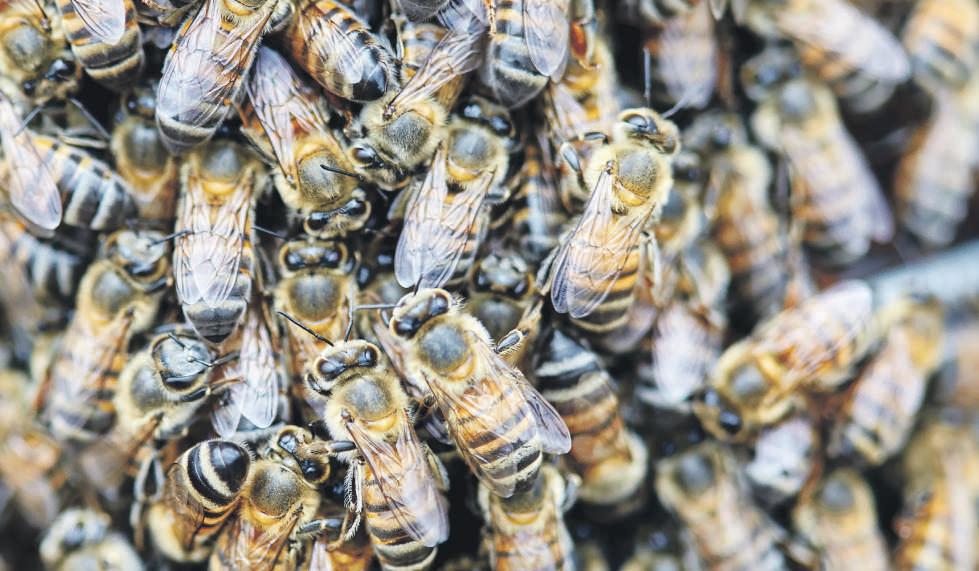
On the other hand, advanced countries with the highest GDP may have been knocked off their perches by Covid-19 and their higher levels of borrowing, resulting in a degree of levelling between the nations.
Five years ago, IMF data showed a very different picture. Household net wealth was high and growing in most advanced economies, with wealth-income ratios in France, Germany and the UK returning to the high levels last seen in the 19th century, and doing so faster than in the USA. See page 8.
Much of France’s empire was closer to hand than Britain’s—a short ride down the Atlantic coast, past Spain to West Africa. France celebrated the fact in its International Colonial Exhibition of 1931, which gave visitors a ‘tour of the world in a day’. A new book from the Getty Research Institute in Los Angeles illustrates some of the visual artefacts used by the French to represent and define their peoples. See page 6-7
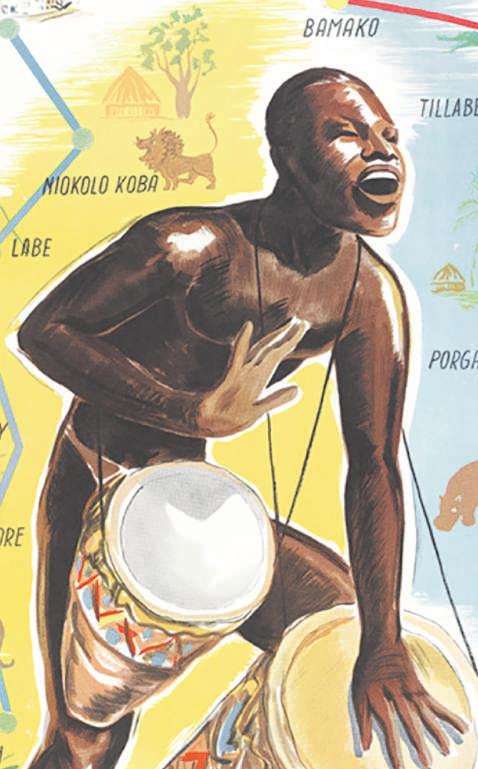
How to promote social democracy to young voters
January 2021 marked the 40th anniversary of the Limehouse Declaration and the launch of the Social Democratic Party (SDP). Through the 1980s, according to the authors of a new book on the future of social democracy, the SDP offered the most coherent ideas to challenge Thatcherism. Social democratic ideas were central to the ethos of the Liberal Democrats, the party formed from a merger of the SDP and the Liberals in 1988-89.
But they also, arguably, became the intellectual bedrock to Blairism and New Labour, leaving LibDem members with the problem of how to regain control of what they see as their own political heritage.
In 2015, the Social Democrat Group was formed to grapple with this problem and a new book of essays has now appeared, with contributions from, among others, Vince Cable, Chris Huhne and Roger Liddle, the latter of whom was more associated with the Labour Party, as Special Adviser on European matters to Tony Blair, before becoming Principal Adviser to the President of the European Commission.
The book is a defence of social democracy and an attempt to show how its ideas can be deployed to combat growing poverty, the aftermath of Britain’s exit from the European Union and the rise of populism, which it sees as an increasing threat. See page 4
Inside the tureen lay an envelope marked ‘Sherlock Holmes, Esq.’. He flicked it to me. It contained a single sheet of Trafalgar blue note paper upon which were written the words: ‘Dear Holmes, Your compulsive urge to interfere in my life presents a tendency of the most diabolical kind. Given our mutual interest in cascades, I suggest we meet at the Old Roar Waterfall above Hastings, conveniently near your bee-farm in Sussex. Shall we say around two o’clock on the afternoon of the first Monday of the coming month?’ See page 18
Parliamentarian or royalist? The mystery of a Civil War rebel
John Poyer is hard to understand. Although he was governor of ‘Penbroke’ [sic] and a force to be reckoned with in the politics of mid-17th-century Wales, he made enemies at a time when many were jockeying for position, trying to anticipate whether King Charles I would survive the Cromwellian revolt or be brought down by it.
Poyer, possibly more principled, called it wrong, prompting Lloyd Bowen, Reader in Early Modern History at Cardiff University, to want to know more.
Author of a more general study of Welsh politics leading up to the Civil Wars, Bowen specialises in the controversies surrounding Charles’s religious and financial innovations in Wales and has offered fresh insights into issues of Welsh allegiance.
Of his earlier book, The Politics of the Principality: Wales c. 1603-1642, The Parliamentary History Yearbook Trust said it gave ‘a convincing explanation for Welsh royalism in the 1640’s’—one that the Welsh History Review felt could not be ignored. See page 5
ON OUR INSIDE PAGES
Page 2 The editor speaks
Page 3 Bad language, Lingualia and survey
Page 4 The future of social democracy
Page 5 John Poyer’s political Civil War flip
Page 6 France’s Art Deco depiction of empire
Page 8 How fiscal policy can help the poor
Page 9 A new Britannica encyclopedia for children
Page 14 The bugler boy in the Napoleonic Wars
Page 15 From Bedales to the Royal Flying Corps
Page 16 Mobile phones as an economic tool
Page 17 The literature of military intelligence
Page 18 A Sherlock Holmes mystery
Page 19 Conan Doyle and literary appraisal
l Bernard Cornwell, who penned the Foreword to Stephen Petty’s historical tale about a bugler in the 95th Rifles, is bringing back his Richard Sharpe character in a new novel this autumn. See page 14.
l What on Earth Publishing’s new children’s encyclopedia marks the first return to print for American partner Britannica since 2012. See pages 9–13. l Professor Simon Ball, writing about Britain’s spy masters, is our latest Leeds U. academic. See page 17

Editorial: Us and Them Stephen Games

Booklaunch 12 Wellfield Avenue, London N10
Distribution Upwards of 50,000 print copies
Website www.booklaunch.london
Publisher/editor Dr Stephen Games editor@booklaunch.london
Design director Jamie Trounce jamie@jamietrounce.co.uk
Assistant editor Maggie Bawden book@booklaunch.london
Advertising Nick Page page@pagemedia.co.uk
Tel: 01428 685319 Mobile: 07789 178802


Printer Mortons Media Group Ltd

Subscriptions Jenny Chalcott subs@booklaunch.london
UK £16.95/Overseas £24.95
With the cacophony of opinion on social media and the pointlessness of much of the popular press, a new publishing phenomenon is emerging—one that Booklaunch is proud to be part of—for readers who want to be taken seriously rather than treated like gossip partners or consumerist dopes.
Some of the most prominent of these new platforms— they’re all online—are The Conversation, Tortoise and The Browser, all of which offer a relatively compact amount of serious, thoughtful, insightful material rather than vast quantities of trivia.
The Conversation, launched in Australia in 2011 but London-based, now publishes in ten regional editions and four languages (English, French, Spanish and Indonesian) and invites topical essays from suitably qualified researchers and lecturers (slogan: ‘academic rigour, journalistic flair’). Each edition is sponsored by a regional consortium of universities and research bodies, and its content can be freely quoted from.
Tortoise, started by a former Times editor and BBC head of news in 2017, makes a virtue of longer, well developed articles rather than breaking news, and sees itself as a cross between TED talks and the Economist, though the New Yorker seems a more obvious precedent.
The Browser culls material from other sources
rather than originating its own, to end up wth five or six daily articles recommended by its two editors, plus a daily podcast and video. It was launched by an ex-staffer at the FT in 2008 and was inspired by The Weekly Dish, started by Andrew Sullivan in 2000 and now often quoted as grossing $500,000 a year.
These platforms all operate by emailing subscribers daily or weekly with a menu of fresh stories that take one either to their own website or, in the case of The Browser, to a story’s source. All invite subscriptions or donations but offer lower-level services for non-payers. Their shared ethos is to identify stories that matter, to get to the big picture, and to care about the consequences.
There’s a notion of openness that links them too. In the words of Tortoise, the sites are independent of political and commercial agendas, free of ads and protective of members’ data. All imply equality and communality between editors, writers and readers.
Booklaunch shares these aspirations but, uniquely, bases its content on books, not on other magazines, nor—in the case of another site called Medium—on a self-electing cohort of independent writers. Unlike other book magazines, it’s the author’s words that we focus on, not the reactions of third parties. That’s why we run extracts rather than reviews: so readers have the benefit
of the real thing rather than responses of untested value.
That’s a worthy aim, and one in which we were recently wished good luck by the Big Issue’s Lord Bird, a man we admire. It’s also why, in addition to appearing online, we choose to come out in print, and in a very large print run. We, and all these new titles, represent little salons distilling intelligence.
What bothers us is the uniformity implicit in the community of interest that Booklaunch and its peers aspire to cultivate. Each publication was started by white Englishmen of similar ages and similar cultural and educational backgrounds (three of us educated at Oxbridge). We have all worked at the highest levels of mainstream journalism and become frustrated with it. And we have all taken advantage of deunionisation to set up enterprises of our own to challenge the giants.
Fine. But where does this leave that much larger demographic whom we carelessly dismiss as less editorially discriminating? ‘They’, arguably, have far greater need of better writing than the cultured few, and aren’t getting it. It’s all very well catering for the catered-for; the great challenge is to undermine the commercialised trash and amateur sensationalism that defraud the unwary because, as we’ve seen in America only too recently, these feed a profundity of ignorance that threatens us all. Agreed?
Bad language Bart O’Fehfon
Tell us the truth
The Booklaunch survey 2
If you missed the survey we emailed recently about your bookreading habits, the deadline has now passed, but we’re keen to get more feedback. Having told us about your enthusiasms, please tell us now what gets your goat.
1. What books that publishers and reviewers have most talked up in the last year have you been most disappointed by?
2. The Tin Ear prize: nominate a celebrated author who seems incapable of good writing. Give us some examples and shame the publisher.

3. Book people seem to love lists (The Sunday Times Top-Ten Lockdown Poetry Anthologies; Indie Bookshops’ Covid-19 Slowest-Selling Travel Guides). Write a list of the five things you most dislike about book lists.
Define the c-word for me
Covid-19 is short for “coronavirus disease 2019”. So …
It’s not an acronym like SARS (severe acute respiratory syndrome).
It’s not an initialism like PPE (personal protective equipment) or WFH (working from home).
It’s not quite a blend / portmanteau word like ‘infodemic’ (‘information epidemic’—the gush of news, including fake news).
So what is it?
One idea is to call it a syllabism. But that doesn’t really work. For a start, the term already exists, referring for instance to the use of a syllabic rather than alphabetic writing system.
The alternative form syllablism is no improvement. It’s less mellifluous, and anyway it too already exists (though not yet widely enough to appear in dictionaries), referring for instance to a poet’s preoccupation with syllable-counts.
More importantly, the constituent elements of Covid19 are not all syllables, so syllabism or syllablism would be misleading.
A better term would be fragmentism
Any other ideas? And can you think of any other abbreviated words that originate in an equally patchy way?
Where do they get it from?
Given that the expanded form of Covid-19 already contains the word virus, it seems slightly odd to speak of the ‘Covid-19 virus’. Yet Google (around the end of January 2021) was giving more than two billion hits for the phrase.
In other words, the awkward phrase seems to have gone viral, ho ho.
The terminologists should have foreseen the problem and pre-empted it by naming the disease Cod-19 instead. Or perhaps not.
In fairness, the phrase Covid-19 virus is not really tautologous in the way that HIV virus is. (Other ‘hidden tautologies’ include PIN number, LCD display, and ATM machine.)
When did you say?
Some interesting datings, from the OED and elsewhere, and via a recent OED communiqué:
Covid-19, unsurprisingly, is first attested in 2019.
Coronavirus in 1968 (in the journal Nature).
AIDS in 1982 and SARS in 2003.
Virus in 1599, though in the sense of ‘venom’; in the
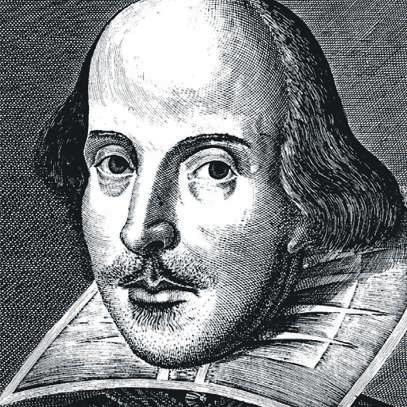
Lingualia Quiz 2
What do the following have in common?
Dick Carter Gus Painter
M.A. Carpenter
Charlie Weaver
Max Marsh (aka Max Fracture)
Johnnie Brook
Al Hill
Claud Greenberg
Fred Cream
Len Amber
Clue: others in the same category include J.P. Branch and Dick Bouquet (aka Dick Battle aka Dick Ostrich). Another clue: the first item—Dick Carter—is slightly misleading. Book prizes for first three winners.
sense of ‘microscopic pathogen’ it was first used in 1881, the year after Pasteur first used it in French. The adjective viral dates back only to 1948, and its extended sense (relating to the rapid spread of info) only to 1989. And the phrase to go viral was first used in 2000, it seems.
Epidemic as an adjective is first attested in 1603, and as a noun in 1799 (or 1757, though used in a figurative way rather than of an actual disease).
Pandemic as an adjective appears first in 1666 (the time of the Great Plague), and as a noun in 1853.
Infodemic dates from 2003 (in relation to SARS).
PPE (in the relevant sense) in 1977. And personal protective equipment way back in 1934.
WFH as a noun in 1995. And as a verb (really?) in 2001. (Not to be confused with WTF, first recorded in print in 1985.)
Social distancing in 1957, though with reference to a snooty attitude rather than to fear of disease.
Quarantine as a noun (in the relevant sense) in 1669, in Pepys’s diary. (An earlier use, dating back to 1609, relates to a widow’s right to continued occupancy of her mansion house.) As a verb, in 1804.
Self-quarantined in 1878.
Self-isolation and self-isolating in 1834 and 1841 respectively (though they tended in the 19th century to be used with reference to countries and their political and economic isolationism).
Care to split an infinitive?
In 1964, TSE (=Eliot) was challenged in the Daily Telegraph by Bertrand Russell over the split infinitive. Russell quoted Lycidas—‘To tend the homely slighted Shepherds trade / And strictly meditate the thankles [sic] muse’—to show that the last line here, unellipted, would read ‘And to strictly meditate …’. A subsequent correspondent, however, wrote to say that the line could equally well read: ‘And strictly to meditate the thankles muse…’ and that Milton had not necessarily stooped. The sequence of letters ended with a Bellocian poem:
Mary, having shot in dozens Sisters, Aunts and Second Cousins, Told the judge with eager zest, ‘I hope to soon bump off the rest.’ Reaching for his black cap, he Cried out, ‘Ye Gods, what infamy! The liquidations I’d forgive But not that split infinitive.’
Results of Lingualia Quiz 1
What do the following have in common? (Booklaunch 7)
average weekly wage / arts and crafts / mass media / motor neurone disease / Martha’s Vineyard / Washington Times / Train à Grande Vitesse
Answer: The clues all share official acronyms with Shakespeare plays. AWW (All’s Well that Ends Well); A&C (Antony and Cleopatra); MM (Measure for Measure); MND (A Midsummer Night’s Dream); MV (The Merchant of Venice); WT (The Winter’s Tale); TGV (The Two Gentlemen of Verona). The Shakespeare acronyms used here are those from The New Oxford Shakespeare. The standard American English source, the MLA Handbook, has some variations, including Ant. for Antony and Cleopatra, and Wiv. for (The Merry Wives of Windsor) No winners, I’m afraid. So Live, Love, Laugh!
4. Do photographs of authors in book reviews influence your buying decisions? Do the pretty and the handsome write better than the lived-in and crumbly, in your experience?
5. Why do you think publishers use photographs in their publicity packs?
6. Did you buy Richard Osman’s book because you’ve seen him on ‘Pointless’? (Go on, admit it.)
7. Which of the following has done most good for the bookselling business: Amazon? Oxfam? bookshop.org? Waterstones? Friendly local bookshops?
8. Do you mostly buy books from online retailers or do you prefer to order through your friendly local bookshop and wait two weeks?
9. Have you ever sussed out a book in your friendly local bookshop and then bought it online? (Be honest.)
10. How friendly is your friendly local bookshop, actually? Out of ten.
11. Can you guess why?
12. Would you choose to forego your discount on a book just to spite Amazon?
13. If a book were only available on Amazon, would you refuse to buy it?
14. Do you think household-name publishers treat authors well? (Really? You really think that? Oh boy.)
15. OK, then: which of these publishing groups is the cuddliest and least rapacious? Penguin Random House? Hachette? Harper Collins? Macmillan? Bloomsbury? OUP? Explain your answer. (Do you work for any of them?)
16. Informal social-media book influencers are now the Trojan horse of big publishing (and smaller publishing too). Knowing that, would you encourage your child to marry a book influencer or disown them if they did?
17. Kindles and ebooks are definitely the way to go, aren’t they?
18. In 2018 over half of all fiction sales were crime thrillers. One book accounted for 30% of the rest. Can you name it, and are you completely fine with that?
19. Who should the 2019 Booker Prize have gone to: Margaret Evaristo or Bernadine Atwood?
20. Is anything fair, when you come to think of it?
Email us your answers and your permission to quote you, or otherwise: book@booklaunch.london. Prizes if we chuckle.
The unexpected Conservative majority in December 2019 was a painful defeat for both Labour and the Liberal Democrats and was compounded by the fact that many of those on lower incomes, whose lives we seek to improve, switched to the Conservatives. This is a serious political failure and we need to consider why it happened.
On 9 September 2016, Hilary Clinton said: ‘you could put half of Trump’s supporters into what I call the basket of deplorables. … They’re racist, sexist, homophobic, xenophobic, Islamophobic.’ It was a catastrophic gaffe that was used repeatedly by the Trump campaign. Not only did it energise Trump’s base, but some who were still undecided thought her insult might be directed at them. She quickly apologised, but the damage was done, perhaps because her words were perceived to reflect the underlying attitude of many liberal members of the Democrats. Social democrats and liberals in the UK should consider whether we have made similar mistakes.
Engaging with these voters will sometimes require us to make compromises. Such compromises are not a betrayal of our values. Those who voted tactically for Hillary Clinton to keep out Trump in 2016, whether from the Left or the Right, were compromising, but they
THE FUTURE OF SOCIAL DEMOCRACY ESSAYS TO MARK THE 40TH ANNIVERSARY OF THE LIMEHOUSE DECLARATION
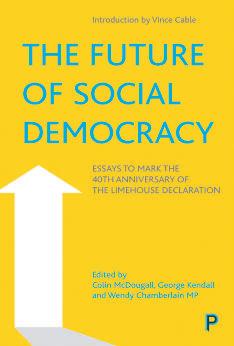
Policy Press
Softback, 144pp 15 January 2021 9781447361268
RRP £12.99
Our price £10.33
were also acting out of deep principle. We want voters to give us tactical support in the UK, but we will be unable to do so if we reject the idea of seeking common ground with them.
Vince Cable
Political parties that could be described as social democratic have been in decline for some years, particularly in the countries where they have historically been strongest: Britain, Germany and in Scandinavia. Others outside the Western world, as in India and Brazil, have largely disappeared. Almost everywhere, competing voices—nationalism, ethnically based populism and authoritarian ‘strong men’—have drowned out the appeal of social democracy and captured much of the electoral base of social democratic parties. That base was in any event contracting because of the decline in manufacturing and unionised employment, and the greater priority for younger voters of new issues like the environment. The main appeal of social democrats— that they offer the best of capitalism and socialism—was increasingly seen to be not credible.
The Covid-19 pandemic could hasten the decline of social democracy but could also help it stage a revival. Certainly, the challenges now being thrown up are those to which social democrats have produced answers in the past: mass unemployment; the re-emergence of large-scale mass poverty in the poorest countries; protectionism and lack of international cooperation; and growing dependence on the state to coordinate, plan and be the health provider, employer and safety net of last resort. Social democrats, in government and out, were key to the post-war consensus that was instrumental in tackling these problems, which have now resurfaced in a new way.
READERS’ COMMENTS
This extract taken from the Forward, Introduction and Chapter 1.
To comment on this book, email your thoughts to book@booklaunch.london
Our online Comment page will launch in the Spring. Subscribe now and we’ll send you an alert when it’s up and running.
However, there are competing political models and ideas. Nationalism and populism are powerful forces in some countries (the US, Russia, China, Brazil, Mexico and India). Then there are what can be called the ‘welfare technocracies’ of East Asia. There are pockets, which may grow, of aggressive and radical individualism. And, in contrast, there are strongly communitarian movements at local level: sometimes inclusive; sometimes exclusive. The issue for social democrats is whether they can offer a mixture of competence and compassion that can transcend the competition in a democratic context.
Who are the social democrats?
The social democratic tribe is a lot bigger than represented by the parties that are descended from the socialist tradition like the UK Labour Party, the Social Democratic Party (SPD) in Germany, and other assorted social democrat parties around Europe and in Australia. There are some social democratic parties that call themselves ‘socialist’, as in Spain, or ‘labour’, as in Norway, or ‘democrat’, as in Italy. We should not include some that call themselves ‘social democrat’ but are rebadged ‘communists’. We should include the US
Despite the efforts of Anthony Crosland and others to achieve a similar clarification in the UK, ambiguity remained, leading initially to the SDP breakaway. Moreover, despite the efforts of Neil Kinnock, John Smith and Tony Blair to cement the social democratic character of the Labour Party, they succeeded only temporarily, leading to the bizarre spectacle of their party being captured by revolutionary socialists. Brexit has also created new geographical and ideological wounds. In the meantime, the Liberal Democrats became the voice of many social democrats, as well as liberals, but is marginalised by the electoral system.
This eclectic mix of parties and political traditions makes it difficult to locate the common denominator. There is a common thread in the Rawlsian tradition of thought, which emphasises individual freedoms alongside a shared sense of fairness and that has at its heart a ‘social contract’. The current crisis is also forcing social democrats to come up with new or reworked policy ideas to tackle new problems or old problems in a new guise.
What is to be done?
Among the most significant challenges for social democrats are mass unemployment, poverty, the problems
Democrats, who never went through a socialist phase. There are also ‘social liberals’ who emerged from classical liberal parties but are now largely indistinguishable from social democrats, like the Canadian Liberals (though they have competition from the New Democrats), and others like the Dutch 66, the Swedish Liberals and Macron’s En Marche where there are big areas of overlap. The Liberal Democrats in the UK are such a hybrid, and the identification often has more to do with a country’s voting system and its history of political schism than meaningful working definitions of social democracy.
What is striking and disappointing is that social democracy has not travelled well outside the heartland of Western Europe, North America and Australasia. In Asia, Lee Kuan Yew’s People’s Action Party (PAP) in Singapore was modelled on the British Labour Party but came to despise the welfare state. On the bigger canvass of India, the Congress Party seemed to have similar values to European social democrats but succumbed to rampant corruption. The same can be said for the Brazilian Workers Party. There are recognisably social democratic parties in many places (Ghana, Jamaica, South Africa, Costa Rica, Japan, Taiwan and Korea) but national idiosyncrasies tend to outweigh what they have in common.
Those national variations stem from different histories. Some social democratic parties, as in Sweden, broke with their revolutionary socialist ancestry over a century ago and have maintained a consistently reformist and democratic personality ever since. In some cases, as in Germany, there was a moment when the party redefined itself as unambiguously social democratic— the Bad Godesberg conference in 1959—and it has remained aloof from parties of the far Left like Die Linke.
EDITOR’S NOTE
posed by big data companies and the weakening of multinational institutions caused by rising populism. Social democrats should remain committed to a Keynesian approach to economic matters, should learn from best practice in other countries and should adopt pragmatic, evidence-based policies.
The policies they should pursue include: a commitment to lifelong training and education; support for generous in-work benefits to low-earner families; making the case for taxing assets whose value has been inflated by recent monetary policies; a more effective authority to counter business takeovers that stifle competition or undermine the country’s science base; and rebuilding the UK’s relationships with our overseas partners to pursue policy objectives that cannot be achieved at a national level. However, social democrats will not return to power in Britain on the basis of policy ideas alone; they will have to overcome the tribal divisions of British political parties and the obstacles of the British ‘first-past-the-post’ voting system by means of tactical cooperation.
Wendy Chamberlain MPThe Liberal Democrats have been arguing for electoral reform for many years, largely focused on replacing the first-past-the-post voting system for Westminster. During that time, despite progress in delivering more proportional systems for both the Welsh Senedd and the Scottish Parliament, the party and others have failed to make a compelling case for change.
Since the alternative vote (AV) referendum during the Coalition period, two further referendums have taken place: on Scottish Independence in 2014 and on leaving the EU in 2016. Putting to one side the position that AV is not in itself a pro-
This book is rooted in the Liberal Democrat party’s problems in re-establishing a presence in British politics. Its title echoes that of another book with the same name that came out in Canada in 1999. Both contain essays. Those in the Canadian book were written by former social-democrat leaders from around the world musing on how to reaffirm social democracy in the face of neo-liberalism and the rise of the right; those in the British book are by British liberals offering more local solutions to vexed policy questions such as housing, free trade and environmentalism. The writing in this latter book is deeply felt; the next step is to sell the vision.
With politics going populist, what must the centre ground do to electrify the electorate? Wendy Chamberlain, George Kendall, Colin McDougall (eds)
John Poyer was Wales’ greatest parliamentarian in Britain’s first Civil War. Then he flipped and went over the Royalists. Why? Lloyd Bowen
EDITOR’S NOTE
What did John Poyer represent: himself or a principle? His contemporaries seem to have written him off and to have written him out of the chronicles of his time. Lloyd Bowen has made it his mission to fill the gap. The questions that he raises can be asked of many political figures who have said of themselves that they did not change their position—it was everyone else that moved. As Bowen says, we should be more aware of the difficulties Poyer faced in trying to remain faithful to a parliament increasingly seeking to engineer his ruin, against a background of vicious national and provincial sectarianism.
Most books examining the British civil wars (c.1642–51) have an entry in their index: ‘Poyer, John’. It usually is only a single entry, however, denoting a brief mention of John Poyer’s role in an insurrection against parliamentary rule in 1648. Poyer rebelled against the parliament which had been victorious in the first civil war (1642–6) and his actions helped to initiate a series of uprisings and provincial revolts which, along with the invasion of the Scottish Covenanters in the summer of 1648, are collectively known as ‘The Second Civil War’.
But Poyer also had a fascinating history before April 1648 which can help us better understand his motivations and actions during that tumultuous spring and summer. He was essentially a nobody; born into an obscure family in a run-down town ‘in a nooke of a little county’, as one contemporary put it, on the western periphery of the British mainland.
Yet he became a leading light of the parliamentarian war effort in this part of the country in the early 1640s and held out as mayor in his bastion of Pembroke as the royalist tide swept up to the town’s walls.

Poyer was a charismatic and capable individual who managed to mobilise the local population in desperate times. His early declaration for parliament should have left him in an enviable position after the king’s defeat in 1646. Many parliamentarians were rewarded with offices and positions of local power as the new order needed trusted servants to implement its policies in the provinces.
This was not to be Poyer’s fate, however. Although he remained governor of Pembroke, he was crossed by local gentry enemies who initially supported King Charles I but later found their way into parliament’s camp. As one Poyer supporter put it at the time, ‘in our distresse [they] were our greatest enemies and successe onlie induced [them] to profess our frindshippe’.
Despite Poyer’s steadfast support of parliament, then, the aftermath of the civil war saw him effectively ‘frozen out’ of local government as his enemies rose to positions of authority through their friendships with powerful figures in parliament and its New Model Army. His marginalisation eventually led to outright resistance, and in early 1648 Poyer rebelled against parliament and the New Model Army, declared his support for the imprisoned Charles I, and even sought aid and assistance from the exiled Prince of Wales.
This royalist revolt spread quickly through south Wales but was ruthlessly suppressed, and parliament sent down Lieutenant General Oliver Cromwell to besiege Poyer and his recalcitrant royalists … After a long and attritional siege Poyer surrendered to parliament’s mercy in July 1648 and was put on trial in Whitehall shortly after King Charles I was beheaded. He and two others were found guilty and sentenced to death, but it was decided to show mercy and execute only one. A child drew lots on their behalf, Poyer lost and on 25 April 1649 he was executed by firing squad in Covent Garden.
The central problem with trying to write about Poyer
is that although he was a man who could inspire considerable loyalty and allegiance, even his staunchest admirers saw him as an irascible and splenetic individual who was difficult to like and admire. His enemies seem truly to have hated him and made sure they told the world how they felt. The result, which few historians have sufficiently recognised, is that we tend to look at him through his adversaries’ hostile gaze. Because he only left a handful of letters and petitions, all ‘official’ in nature, we invariably fall back on reports and pamphlets by others, all written with a very jaundiced eye.
The principal author of such accounts was Poyer’s bête noire, John Eliot of Amroth (Pembrokeshire), a skilled publicist and Poyer’s implacable antagonist. Eliot was adept at inserting his partial and prejudiced view of Poyer (often anonymously) into many forms of print, and historians have often treated such pieces uncritically.
The present volume is no apologia for John Poyer but does argue that we need a more critical and evaluative eye than has hitherto been the case. In fact, our modern view of Poyer often comes uncomfortably close to the perspective promulgated by John Eliot in the mid-seventeenth century. This volume acknowledges that while Poyer was a divisive and contentious figure we should none the less be more aware of the difficulties he faced in trying to remain faithful to a parliament which was increasingly seeking to engineer his ruin.
There is something unsavoury about a man who changes his allegiance and shifts his positions. However, it is one of this book’s arguments that Poyer was, in fact, a consistent politician who failed to adapt to the shifting politics of his times and ended up before a firing squad because of his inflexibility. Rather than seeing Poyer’s royalist declaration in 1648 as an aberrant shift from his earlier public politics, this volume argues that we need to take Poyer’s own words more seriously, that in 1648 he ‘still continue[d] to [his] … first principles’. Poyer considered that parliament had become a radical body which had fallen away from its original undertaking to seek moderate reformation and an accommodation with the king; it had departed from him rather than vice versa.
This volume, then, seeks to better understand and contextualise Poyer within his milieu and the local and national politics of his times. It argues that Poyer needs to be located within the bitter factional politics of civil war Pembrokeshire, and that we should pay greater attention to the connections these factions made with figures at Westminster. This study is the first to explore in any depth Poyer’s background, and it reveals that he was an intimate of the Meyrick family of Monkton, near Pembroke. This helps place him within the orbit of the influential Earl of Essex, leader of parliament’s army in 1642. His brother-in-law and fellow parliamentarian soldier Rowland Laugharne was also close to Essex, as was Poyer’s sometime ‘master’, the Pembroke MP, Sir Hugh Owen of Orielton.
On the other side of this factional divide we can locate Poyer’s enemies, principal among them being the Lorts of Stackpole and their allies John Eliot and Griffith
9781786836540
RRP £14.99
Our price £14.36
READERS’ COMMENTS
To comment on this book, email your thoughts to book@booklaunch.london
White. The factional politics of civil war Pembrokeshire is a murky business which no previous study has satisfactorily explored or understood. For example, the role of John White, MP for Southwark, and Richard Swanley, the parliamentarian vice admiral, in assisting the Lorts and frustrating Poyer’s requests for promotion and payment of his arrears, is discussed here for the first time. Chapters 3 and 4 offer a sustained analysis of the ways in which such political connection and factional confrontation were important in shaping Poyer’s civil war experience.
A discussion of Poyer’s life during the 1640s, then, reveals something important about the conduct of provincial politics in the transformed circumstances of civil war. The capacity to make and sustain political connections at the centre was crucial in obtaining and maintaining parliament’s good graces. In this, Poyer’s enemies were more adept and agile than he and his associates were, and the appointment of John Eliot as Pembrokeshire’s ‘agent’ at Westminster in early 1645 is shown here to be crucial. Through an analysis of Poyer’s experiences, then, this volume offers more general insights into the conduct of political business in the aftermath of the war and the means by which local power was acquired and preserved.
In examining the operation of political connection across the 1640s, this book also offers a case study of the ways in which the fissures within the post-war parliamentary coalition were transmitted into the provinces. The rise of the New Model Army and of political Independency after 1646 offered a rich set of opportunities for the Lorts and their allies. Poyer, Laugharne and their associates, by contrast, looked to the more moderate Presbyterian political bloc to represent and defend their interests.
Thus it was that the factional differences within Pembrokeshire’s parliamentary politics assumed a more overt ideological form, although issues of power, money and authority were always present in these confrontations. This is not to say that ideological divisions were not present before, but rather that they were instrumentalised and weaponised, and adopted new forms when the immediate business of fighting the royalists was done.
In their political alignments, however, the Lorts had chosen a more potent set of allies than Poyer. TheEarl of Essex died in September 1646 and although Poyer and his associates still had some political successes, such as the election of his Presbyterian ally Arthur Owen to the Pembrokeshire constituency seat, the Presbyterians lost ground rapidly to their Independent opponents both centrally and locally as 1647 progressed.
Poyer’s presence among these Presbyterians places him as something of a political moderate, but the discussion here reveals that he was a religious conservative also. Somewhat unusually among precocious parliamentarians, Poyer was not a thoroughgoing puritan who had advanced ideas about Protestant reform. He was certainly anti-Catholic, and his first emergence into public view was as a bulwark against
We welcome either written responses or MP3 voice tracks. All contributions are moderated. Our online Comment page will launch in the Spring. Subscribe now and we’ll send you an alert when it’s up and running. continued
We don’t tolerate colonialism any more, but the art that defended it still appeals to us. That’s uncomfortable Peabody, Nelson, Thomas (eds)
EDITOR’S NOTE
Look at this big spread of Art Deco pictures. We like Art Deco: it was the most successful art movement of the 20th century—instantly popular around the world. But these images sum up France’s ‘golden age of colonialism’ and so we ought to deplore them. That dilemma lies at the heart of Visualizing Empire, a book based on potent materials acquired by the Getty Research Institute but whose siren temptations it has to argue with. This is not the first time custodianship and political critique have pointed in different directions, but it could become a test case.
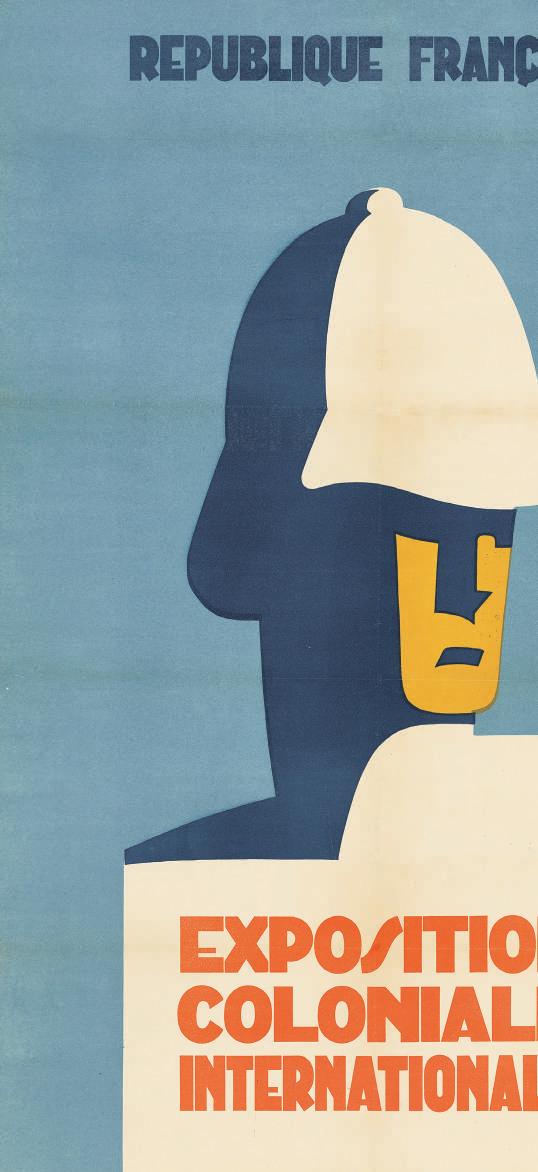
In the mid-nineteenth century, when few Europeans had travelled overseas, anyone with a shilling or a franc could step into the cultures of other continents in their nation’s empire at the London Crystal Palace Exhibition (1851) or in Paris at the Exposition Universelle (1855), where exhibits and other materials glorified and promoted the benefits of their empires. In the decades that followed, as the French Empire rapidly expanded, world’s fairs increasingly focused on the colonies in order ‘to transform public indifference, and draw attention to both the necessity and the legitimacy of the colonial project.’ These exhibitions displayed economic and social concerns, products, and overseas infrastructure, as well as eugenics and racial violence in pavilions populated by flora, fauna, and, eventually, people. France’s colonial expansion and dissemination of propaganda were similar to those of Italy, the Netherlands, Portugal, Germany, and Great Britain.
By the end of World War I, France had entered what French historian Jean Suret-Canale has called the ‘golden age of colonialism.’ Having fortified their colonial holdings in the Caribbean, Latin America, Africa, the Indian Ocean, and Asia, the French could rightly claim to have expanded their dominion to the four corners of the earth. This point was celebrated in the summer of 1931, when 33 million people attended the Paris Exposition Coloniale Internationale. In that world’s fair, imperialism was not a subtheme, but rather the explicit purpose; visitors could, as the government’s slogan advertised, have a ‘tour of the world in a day’, touching down on continents and oceans that represented the breadth of France Overseas.
As a result of the imperial ‘civilizing mission’, and in the span of less than a century, residents of the metropole and colonies experienced ‘the dissemination of thousands of pieces of audio/visual material’ and were ‘immersed in a veritable colonial bath. Each image participated in the elaboration of a social imaginary, through which the national community, appropriating a common patrimony, constructed itself.’
The essays in this volume focus on the role of visual culture in these processes of national self construction, using a collection of materials held in the Getty Research Institute (GRI) acquired from the Paris-based Association Connaissance de l’Histoire de l’Afrique Contemporaine (ACHAC) archives. Through a diverse and interdisciplinary range of essays, our goal has been to reveal the complex ways in which the French displayed, defined, and represented their empire. As one of the panels in a recent exhibition at the Deutsches Historisches Museum argued, ‘the world of colonial images in the German Empire shows that visual relationships are also power relationships. Photographs, consumer goods, and advertising all transmitted themes of colonial conquest and racist stereotypes.’
The Global Impact of the ACHAC Research Group
During a visit to Algeria, French presidential candidate Emmanuel Macron stated in an interview broadcast on Echorouk TV on 14 February 2017 that ‘[c]olonization is
part of French history. It is a crime. It is a crime against humanity, a truly barbarous crime that is part of our history, and we need to confront this past by apologizing to the women and men against whom we committed these acts.’ He sparked a firestorm, unleashing a furor that underscored France’s incapacity to come to terms with its complex past, a past whose spectre, whose legacy continues to haunt the contemporary landscape. It is literally a past that, as French historian Henry Rousso famously claimed, does not pass. Furthermore, ‘[o]ver time, colonial culture has come to infiltrate the cultural, political, and social unconscious. Traces and vestiges are to be found everywhere.’ Perhaps not surprisingly, those European countries that gathered at the Berlin Conference in 1884–85 to negotiate territorial allocations find themselves today reckoning with that history, to varying degrees. Postcolonial populations living in Europe (many of whom are descendants of the formerly colonized) have, alongside activists, called for greater official recognition of some of the darker chapters of that history. In France, for example, these claims have also coincided with demands for a museum devoted to colonial history. To this end, the work of organizations such as ACHAC is of great interest in terms of raising public awareness of these matters, but also deeply politicized and often controversial.
The official poster for the Paris Exposition Coloniale Internationale of 1931, held in the ACHAC collection, is an iconic image of interwar French colonialism. Designed by graphic and fine artist Victor Jean Desmeures, the poster reduces the people and architecture of the French colonial empire into schematic images that recapitulate the racist stereotypes that undergirded colonialism’s ‘civilizing mission’. The central group of four types represents nonwhite races (Arab, Native American, African, and Asian) by means of skin color, physiognomic features, and clothing. In the background, Angkor Wat’s spires and a North African tower evoke the exotic architecture of France Overseas. Like the architecture of the pavilions, these representations of the races had a long history within French culture. Immediately recognizable, the figures conveyed meanings to the French public that had accumulated over decades, culminating in the apogee of the Exposition Coloniale and its spectacle.
In the poster, we see what seems to be a minaret topped with a French flag. Or it might be French colonial building in the synthetic neo-North African style developed under Maréchal Hubert Lyautey’s leadership in Morocco. On the right, Angkor Wat’s towers are clearly identifiable, familiar after decades of depictions and reconstructions at previous expositions. The grouping forms a static composition of four racial types, an allegorical group that stands for both peoples and places. Reduced to a few characteristic features, the human figures are flattened into a non-place and nontime. The buildings are similarly iconic. The vivid colors and simple forms are arresting, particularly because they are monumentalized on the huge format of the poster (54 by 73 cm). The people depicted are almost

lifesize, but, due to their schematic representation, they produce difference rather than identification with the viewer, who is assumed to be white.
The Imperial Archive
The poster and other objects from the Exposition Coloniale belong to two archives: the ACHAC collection within the Getty Research Institute (GRI) archives and the so-called imperial archive. The imperial archive is not a physical one, but, rather, a concept that encompasses the long history of representations of the races, architecture, and geography of the colonies. Beginning from Michel Foucault’s work on genealogy and the archive, scholars of colonialism have extended his theories to the imperial archive. Foucault understood the archive as part of the systems that control enunciation and knowledge. It is neither the sum of the texts that a culture preserves nor those institutions that record and preserve them. For Foucault, the archive of a society, a culture, a civilization, or a whole period cannot be described exhaustively, particularly our own archive. ‘It emerges in fragments, regions, and levels, more fully, no doubt, and with greater sharpness, the greater the time that separates us from it.’ The analysis of the archive involves a privileged region that is close to us yet different, ‘it is the border of time that surrounds our presence … it is that which … delimits us.’
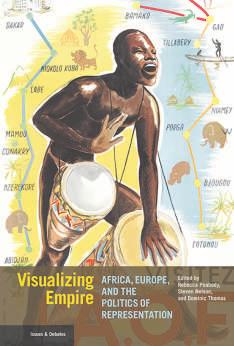
Postcolonial thinkers have extended Foucault’s concept of the archive to define the imperial archive, the epistemological systems through which colonizing powers exercised control over their distant empires. Ann Laura Stoler links the archive to colonial power: ‘What constitutes the archive, what form it takes and what systems of classification signal at a specific time, is the very substance of colonial politics.’ Thomas Richards characterizes the imperial archive as ‘a fantasy of knowledge collected and unified in the service of the state and Empire.’
For six months in 1931, the Exposition Coloniale Internationale in Paris welcomed the public to celebrate the accomplishments and the future of colonialism, featuring sections for the French colonies and the colonial empires of Belgium, Denmark, the Netherlands, Italy, Portugal, and the United States. Advertised as ‘Le tour du monde en un jour’ (A tour of the world in one day), the Exposition Coloniale gave its visitors the experience of the world’s cultures and peoples without the inconvenience and danger of global travel. At the exposition, as in the poster, representative objects and peoples from the colonies were displayed and reconstituted into a new colonial realm, frozen in a timeless state, as if they were outside evolutionary change and the effects of modernization. The exposition promulgated a contradictory message of the colonies as the Orient—the site of degeneration, sensuality, and irrationality—and the colonies as a laboratory of Western rationality. It occupied a middle region where the norms, rules, and systems of French colonialism both emerged and collapsed.
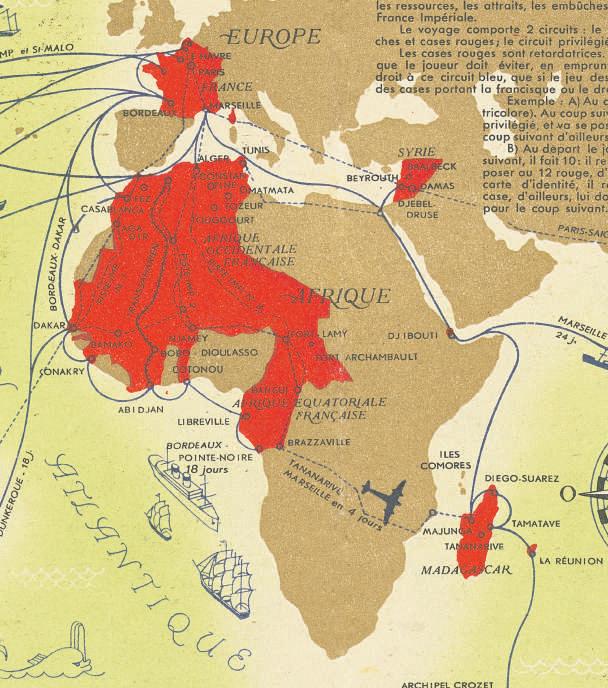
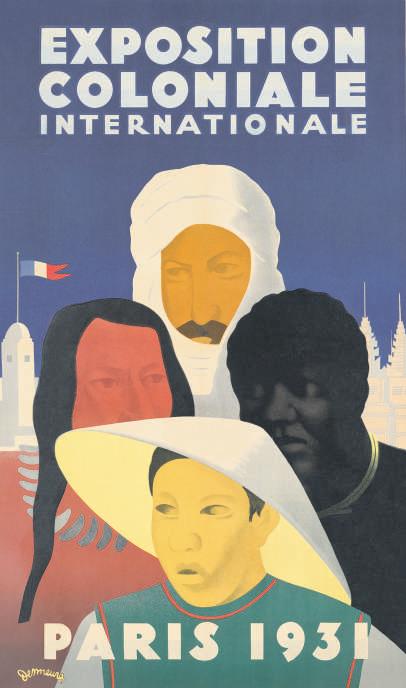

The Exposition Coloniale made fictions from continued in the book
Getty Publications
Softback, 200 pages

12 January 2021
9781606066683
RRP £45.00
Our price: £36.43
CLICK
READERS’ COMMENTS
To comment on this book, email your thoughts to book@booklaunch.london
We welcome either written responses or MP3 voice tracks. All contributions are moderated. Our online Comment page will launch in the Spring. Subscribe now and we’ll send you an alert when it’s up and running.
In most advanced economies, household net wealth is high and growing. After a steady decline throughout much of the twentieth century due to the adverse shocks of the two world wars and the stock market crash of 1929, household wealth-income ratios have been rising rapidly since the early 1970s, with a swift acceleration during the new-economy boom of the 1990s. This increase has been particularly pronounced in Europe.
In the United States, wealth has increased at a slower pace, marked by two significant corrections during the financial crises of 2002 and 2008. Japan has followed a more idiosyncratic path, with stronger wealth accumulation during the 1980s, followed by a decline in the early 1990s after the bursting of the asset price bubble. In most countries, the global financial crisis severely affected the net wealth of households, but after a steep decline in 2008, most wealth ratios bounced back to their previous levels.
Today, households’ net wealth ranges between three and six times GDP in most advanced economies. These are high levels by historical standards. Based on long-term series constructed for four large advanced economies (France, Germany, the United Kingdom,
INEQUALITY AND FISCAL POLICY Clements, de Mooij, Gupta and Keen (eds) International Monetary Fund Softback, 442pp
September 2015
9781513567754
RRP £39.95
and the United States), Piketty and Zucman (2014) show that wealth-to-income ratios are returning to the high values observed in Europe in the nineteenth century.
Abstracting from country-specific developments, the sharp increase in wealth accumulation during the past 40 years was driven by a series of common factors. First, the growth slowdown following the 1973 oil shock raised the interest rate-growth differential, mechanically inflating the wealth-to-output ratio. Second, valuation effects also played a major role. Asset prices grew rapidly during the period: the new economy boosted financial asset values in the 1990s, whereas the 2000s saw a sharp acceleration in real asset prices, reflecting in some cases the formation of property market bubbles. Finally, in some countries, private savings have increased over time as a result of structural factors, including population aging; the financial deregulation of the 1980s, which increased households’ participation in financial markets; and the development of funded pension systems.
Global Trends
The availability of household balance sheet data is more limited for emerging markets and low-income countries.
Credit Suisse (2013), which collects and reports data at a global level, finds that household wealth has increased in all regions of the world since the early 2000s. Global household net wealth rose by about 110 percent between 2000 and 2013, while net wealth per adult rose by 80 percent. Household wealth declined significantly during the financial crisis in 2007–08, but recovered subsequently and exceeded its precrisis level from 2012 onward. This trend was observed in all regions of the world and in most countries, with the exception of some European countries.
READERS’ COMMENTS
To comment on this book, email your thoughts to book@booklaunch.london
We welcome either written responses or MP3 voice tracks. All contributions are moderated. Our online Comment page will launch in the Spring. Subscribe now and we’ll send you an alert when it’s up and running.
Today, wealth is unequally distributed across regions. Both North America and Europe account for about one-third of global wealth, while 20 percent is held in the Asia-Pacific region. The rest of the world (China, India, Latin America, and Africa) owns the remaining 16 percent of total household wealth despite hosting 60 percent of the adult population.
Wealth Composition
The composition of household portfolios varies widely across countries). In general, nonfinancial assets represent more than half of total wealth. Spain and New Zealand are among the advanced economies with the highest share of real assets (more than 70 percent of gross assets at the end of 2012). The United States is an outlier with financial assets representing about 70 percent of the total.
Many factors can explain the cross-country differences in wealth composition. In general, the share of financial assets is higher in countries with private pension systems, a large public housing sector (which discourages home ownership), a high level of financial development, and smaller households (large households tend to accumulate more real estate assets).
small fraction of total net wealth. In Denmark, this share is even negative, reflecting few incentives for the middle and lower classes to accumulate assets in a country with strong social security and public housing programs.
From the beginning of the twentieth century until the 1970s, wealth inequality declined dramatically in most countries for which long time series of wealth distribution are available. This trend has reversed in the past three decades, with wealth inequality rising in most advanced economies. For instance, between the mid1980s and early 2000s, the growth of wealth in Canada and Sweden was all concentrated in the two upper deciles of the wealth distribution. During the same period, the Gini coefficients of wealth distribution in Finland and Italy rose from about 0.55 to greater than 0.6.
In the United States, the Gini coefficient for wealth, after rising steeply between 1983 and 1989 from 0.80 to 0.83, remained stable until 2007, and then increased sharply to 0.87 during the financial crisis. Wealth inequality has risen for a number of reasons. The stock market boom of the 1990s was particularly beneficial to rich households who own higher proportions of stocks, bonds, and other financial products than poor households do. Tax reforms, including lower marginal
Differences in risk tolerance, taxation, and valuation effects also influence the composition. For instance, the Swedish tax reform of 1991, which reduced capital income taxation with the introduction of a flat rate, had a lasting impact on the portfolio composition, increasing the share of financial assets.
In emerging market and low-income economies, household balance sheet data are generally not available. Based on survey data, it seems that the share of nonfinancial assets is even larger than in advanced economies. This share apparently exceeds 80 percent in some countries, such as India and Indonesia.
Wealth Distribution
Wealth is very concentrated within countries. Household wealth is much more unequally distributed than income. The Gini coefficient of wealth in a sample of 26 advanced and developing economies in the early 2000s was 0.68, compared with a Gini of 0.36 for disposable incomes. The main reason for this discrepancy is that high-income individuals have higher saving rates and thus accumulate wealth faster than do poorer households, and they generally hold riskier assets with higher yields.
However, there are important country differences. The share of wealth held by the top 10 percent ranges from slightly less than half in Chile, China, Italy, Japan, Spain, and the United Kingdom, to more than two-thirds in Indonesia, Norway, Sweden, Switzerland, and the United States. In Switzerland and the United States, where wealth is most unequally distributed, the top 1 percent alone holds more than one-third of total household wealth.
In most countries, the lowest 50 percent of households in the wealth distribution generally hold only a very
EDITOR’S NOTE
tax rates on top incomes and lower taxes on all forms of capital, also played a role in the widening of wealth disparities during the period.
Taxing wealth to reduce inequality
There are several quite different types of taxes on wealth. These taxes can be grouped into two broad categories: those that apply to wealth holdings—immovable property tax and net wealth tax (NWT)—and those that apply to wealth transfers, which is further divided into transaction taxes (levied when the asset is sold) and gift and inheritance taxes (levied when the asset is given). Their base is generally the gross value of assets but some taxes bear on net wealth (assets minus liabilities).
Taxes levied on wealth, especially on immovable property, can be used for redistributive purposes. These taxes, of various kinds, target the same underlying base as capital income taxes, namely assets. Because wealth is concentrated among the better off, even a small proportional tax on the capital stock can increase progressivity. Wealth taxes can thus be considered a potential source of progressive taxation.
[But] the redistributive properties of wealth taxes come at a cost. Capital taxes, if too high, can have high efficiency costs because of their distortionary effects on savings and investment. Moreover, taxing capital can be administratively difficult in light of its mobility, with the risk of creating ample evasion and avoidance opportunities. Another issue is that the mobility of capital allows firms to shift a large share of the burden of these taxes onto labour or consumers, thereby affecting the distributional consequences.
Revenues from Wealth Taxes
Although wealth taxes can, in themselves, con-
continued in the book
Governments influence economies by adjusting spending levels and tax rates: their strategy for doing so is what we call fiscal policy, and this goes hand in hand with monetary policy, which tells central banks how much money to issue. This book argues that fiscal policy is a government’s most powerful tool for addressing inequality and that with a good mix of policy instruments, countries can narrow the wealth-poverty gap and improve efficiency. This needs to be read not just by politicians but by all who hold their feet to the fire. Available in the UK from Eurospan: www.eurospanbookstore.com. Find other IMF titles at www.imf.org/pubs.
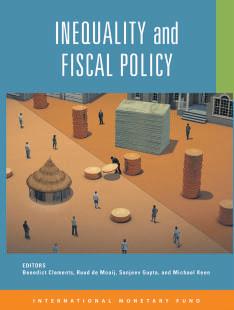
Tax policy may help the poor but have unwanted trade-offs. Theory and case studies offer guidance. Clements, de Mooij, Gupta, Keen (eds)

Hardback, 424pp
1 October 2020
9781912920471
RRP £25.00
Our price £19.99
Lloyd and J.E. Luebering
Britannica has been inspiring curiosity and the joy of learning since 1768. This book continues that tradition. It will take you on an amazing journey through all of history and across the Universe. You’ll have the opportunity to dive into a black hole (and emerge unscathed!) and take a tour of a medieval castle. You’ll also be given the power to peer into the future and learn about what might matter most to us here on Earth. Each time you turn a page, you’ll find something new to explore—and, maybe, you’ll even be a bit alarmed, like I was, when you run across the section on creepy crawlies.

But as surprising and fascinating as each page is, everything we are sharing with you is always subject to change. And that is something that we embrace: watch for sections that describe Known Unknowns. The scholars, researchers and other brilliant minds who have helped us create this book are the ones who, in their dayto-day lives, are shaping the boundaries of knowledge. They’re driven by their passion and their dedication to accuracy and, because of that, they’re helping all of us better understand the world. And that includes understanding what we don’t know yet.
We believe that facts matter, and we strive for accuracy through rigorous fact-checking of all the information we share on every page of this book.
Chapter 1: Universe
Buckle up for an incredible journey through our Universe. At this moment you are riding on an enormous ball of rock. That rock is soaring through space at thousands of miles an hour in a swirling galaxy of billions of giant balls of fire. That rock, of course, is our Earth. And the giant balls of fire are stars, including our own Sun. I hope that fact alone is enough to convince you that reality is so much more amazing than anything you can make up.
In this chapter, we begin with an unimaginably tiny speck of infinite energy from which the Universe exploded into existence 13.8 billion years ago and finish with a Known Unknown: how, when, or if the Universe will come to an end. Which is a reminder that for every answer we find, there are dozens more questions: is there intelligent life somewhere else in the Universe? Why is there more matter than antimatter? What would happen if an astronaut fell into a black hole? There’s lots to discover, even about the unknown.
The Big Bang
The Big Bang is the moment we think the Universe was born 13.8 billion years ago. It describes how a teeny-tiny dot suddenly expanded faster than the speed of light, creating the entire Universe. Belgian astronomer Georges
Lemaître, who first proposed the theory in 1931, called the dot the primeval atom. All matter in the Universe began in this tiny dot and eventually became everything you see around you today.
What happened in the Big Bang?

The Big Bang took place in a split second. Scientists think it was an expansion rather than an explosion. Everything started out incredibly hot, billions of degrees in temperature, but then cooled. When it cooled to thousands of degrees Celsius, atoms joined together and formed matter. This eventually clumped together to make stars, galaxies, solar systems and planets.
Evidence for the Big Bang
Our best proof for the Big Bang comes from something called the Cosmic Microwave Background (CMB), seen in our photo of the night sky. The picture shows heat left over from the Big Bang that spread thinly all over the Universe. The image was taken by scientists using NASA’s Wilkinson Microwave Anisotropy Probe (WMAP).
Pigeon interference
In 1965, American astronomers Arno Penzias and Robert Wilson were using a radio telescope to study the Universe when they saw a
For 250 years, Encyclopaedia Britannica was the world’s foremost source of knowledge. Now there’s a children’s version Chris
LIGHTER THAN AIR
The first passengers on a hot-air balloon flight on 19 September 1783 were a sheep, a duck, and a rooster. They all survived. Humans took to the air in a balloon two months later. These early pioneering experiments kick-started the history of aviation. They led to the development of the motor-powered flying machine. Hot-air balloons also played a key part in establishing the ‘ideal gas law’, which describes how gas temperature, pressure, and volume affect each other.
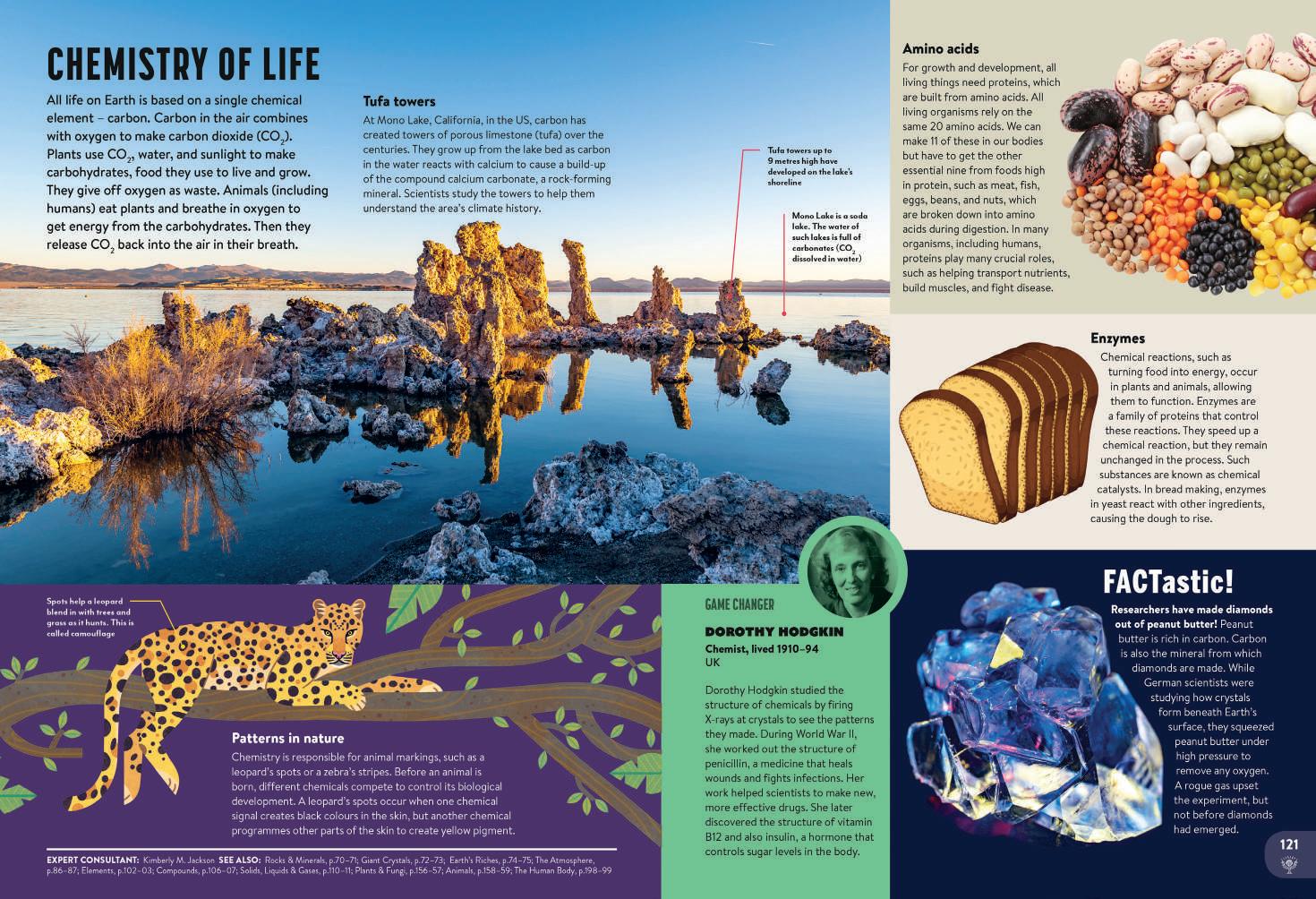

The ideal gas law
Three gas laws combine to make the ideal gas law: Boyle’s, Charles’s, and Gay-Lussac’s. Boyle’s gas law states that if a gas expands, its pressure drops. Charles’s law states that as temperature rises, gases will expand proportionally – as long as the pressure stays the same. Gay-Lussac’s law states that if the volume stays the same, pressure will increase as the temperature increases.
THE DEEP SEA

The ocean is the planet’s largest habitat, most of which is deep sea, yet scientists have explored only a fraction of the deep sea floor. In fact, we know more about the surface of the Moon than we do about the deepest ocean. The invention of new underwater vehicles called submersibles is changing all that, revealing many kinds of strange and fascinating creatures.
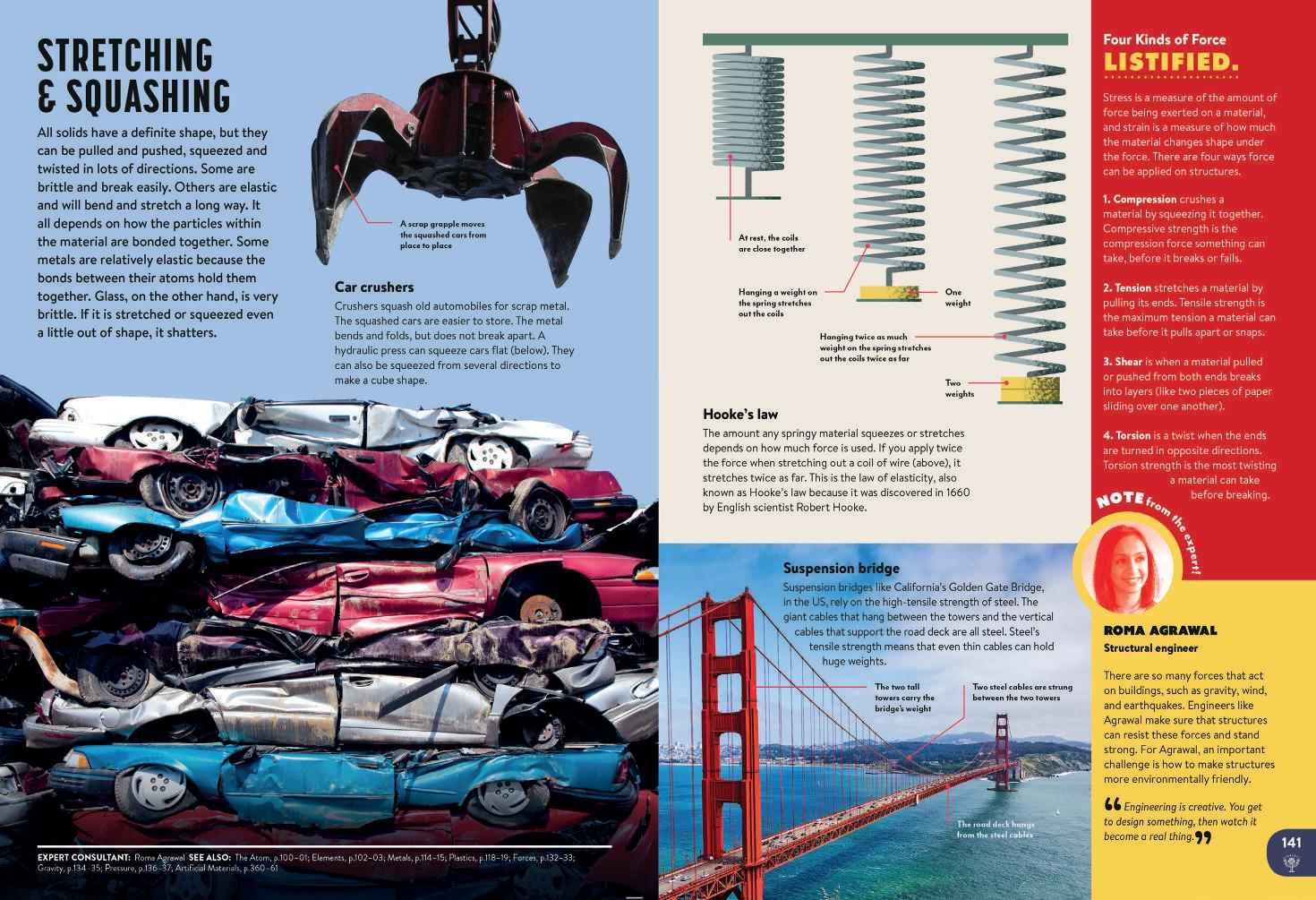

LAYERS OF THE SEA
Scientists divide the ocean into layers according to depth, pressure, and the amount of sunlight they receive. In the deepest zone, the pressure is so great it’s as if an elephant is standing on each square inch of the ocean floor.
Glow-in-the-dark
Many animals in the deep sea are bioluminescent – they light up in the dark. They can do this because of a chemical reaction in their bodies or in bacteria that they host. Female deep sea angler fish, which live in the twilight and midnight zones, have a bioluminescent bacteria-filled lure on the end of a long fin like a fishing rod. The light attracts prey towards its tooth-filled mouth.
The tripod fish is 30–40 centimetres long and stands on stilts formed by its pelvic and tail fins. It is then at the right height to catch passing prey swimming in the current.
Deep-sea exploration
Note from theexpert!


Snailfish


The snailfish is 15–30 centimetres long. In 2017, Japanese scientists filmed a snailfish 8,178 metres deep in the Pacific Ocean’s Mariana Trench –the deepest place on Earth.
Underwater vehicles called submersibles are specially strengthened to resist high pressures at great depths. They enable scientists to observe deep-sea animals. Scientists sometimes bring creatures to the surface in cooled and pressurized tanks so that they can study them in the laboratory.


were during vacations to the Mediterranean Sea as a child. Fascinated by the diversity of animals in the sea, she went on to study zoology and marine biology.
“ Only when you go down to the bottom of the ocean in a submersible do you start to understand how huge this habitat is.”

RELIGIOUS BELIEF
What do people believe in? Statistics show that with 4.4 billion followers between them, Christianity and Islam are the world’s two largest religions. Each has many branches. For example, Catholicism is a branch of Christianity, and Sunni is a branch of Islam. Some religions are a mix of different beliefs and practices. There are also millions of people who have no religious beliefs.
STOPPING CLIMATE CHANGE

EDITOR’S NOTE
We know climate change is harming our planet, and we also know human beings are causing much of it. But what can be done to stop it? In 2015, an international agreement was reached in Paris and later adopted by all nations. They said they would keep global temperatures within a safe limit by reducing their greenhouse gas emissions, but progress has been slow. Now many people are demanding that more urgent and more drastic action is taken to limit the damage to ecosystems, species, and our common future.
OTHER RELIGIONS
850 million, including:
1. Falun Gong (10 million): Combines meditation techniques and ritual exercises. Founded in China, 1992.
2. Cao Dai (8 million): Takes ideas from Daoism, Buddhism, Confucianism, and Roman Catholicism. Founded in Vietnam, 1926.
3. Baha’i faith (5–7 million): Belief that all people belong to one religion with one God. Founded in Iran, 1863.
4. Confucianism (5–6 million): An ancient religion that follows the teachings of the great Chinese thinker Confucius.


5. Jainism (4 million): Faith with belief in the eternal human soul. Has roots in India in the 6th century BCE
6. Shinto (3–4 million): Followers believe in ‘kami’ (spirits) and visit shrines. Founded in ancient Japan.
7. Wicca (1–3 million): Centres on witchcraft, with a focus on nature. Spread from England in the 1950s.
8 Rastafari (1 million): A religion and political movement that began in Jamaica in the 1930s.
9. Tenrikyo (1 million): Shinto-based religion whose followers believe in one god called Tenri-O-no-Mikoto. Started in Japan in the 1800s.
10. Zoroastrianism (1 million): Worship the supreme god Ahura Mazda. Began in Iran in the 6th century BCE
9
Climate protests
In 2019, millions of people around the world protested the way governments were handling climate change, including these Extinction Rebellion (XR) supporters in London, UK. XR is a worldwide protest group demanding that governments take immediate action to stop mass extinction of species by reducing greenhouse gas emissions to zero by 2025.

READERS’ COMMENTS
Reaching a safe limit
Text-heavy books don’t work for children any more: kids are too easily tempted away by more visual alternatives. Britannica’s challenge, then, was how to deliver meticulous and authoritative information engagingly. Their answer is a stunningly designed 424-page compendium of over 1,000 powerful photos and explanatory illustrations, all with the visual punch of an Avengers movie, plus bite-size chunks of information, delivered in appealing formats including lists, quizzes, knowledge connectors and unusual facts. The story arc is refreshing, too: a timeline of the universe. See www.whatonearthbooks.com for more.

Scientists warn that global warming of 2°C would severely damage ecosystems, human health, livelihoods, food and water security, and infrastructure. A safer limit would be below 1.5°C. To keep to safe limits, governments, businesses, and individuals must take action.
To comment on this book, email your thoughts to book@booklaunch.london
We welcome either written responses or MP3 voice tracks. All contributions are moderated. Our online Comment page will launch in the Spring. Subscribe now and we’ll send you an alert when it’s up and running.


When the 95th Rifles was formed in 1800, buglers were given the special role of transmitting signals ordered by their officers. Each of the ten battalion companies was allocated two buglers and right from the beginning buglers were considered as belonging to a company. First and foremost, they were soldiers.
At a time when battles were noisy and confusing affairs, a bugle call could be heard above the din. A bugle call would carry some distance even though muskets crashed and cannon roared. Military bugles are capable of sounding five notes ranging from low C to high G, a span of one-and-a-half octaves. Each regiment of Rifles or Light Infantry had its own regimental call which would be recognised instantly by the officers and men.
The Regulations for Riflemen laid down the meanings and notations for bugle horn signals. There were signals for ‘March’, ‘Skirmish’, ‘Fire’, ‘Cease firing’, ‘Retreat’ and so on.
Buglers would need considerable skill to master their breathing and regulate their pitch. A bugler also needed to develop other skills, such as the ability to perform under pressure, self-discipline and quickness
OVER THE HILLS TO TALAVERA THE ADVENTURES OF BUGLER
GEORGE MILTON
Chosen Man Media
Softback, 90pp 16 November 2020
9781527272675
RRP £9.99 plus p&p
From: https:// chosenmanmedia. com
READERS’ COMMENTS
To comment on this book, email your thoughts to book@booklaunch.london
We welcome either written responses or MP3 voice tracks. All contributions are moderated. Our online Comment page will launch in the Spring. Subscribe now and we’ll send you an alert when it’s up and running.
of thought, for these were all crucial to survival in the chaos of the battlefield.
Buglers of the Rifles functioned in three ways: they could act individually, in pairs or sometimes as the complete Corps of the Bugles.
The Corps of the Bugles was under the command of the Bugle Major. He was a senior sergeant and reported directly to the Adjutant. Each bugler would pick a comrade from his company and the pair would become inseparable. The special status of a bugler was marked by exemption from mess duty and cooking.
The life of the Regiment was governed by bugle calls. At dawn, Reveille was sounded by two buglers. The Orderly Bugler sounded ‘Breakfast’ followed by the Drill Call. Buglers would operate on a rota basis.
After drill, the Orderly Bugler sounded the Buglers Call. Upon hearing this, all the Corps of Bugles assembled and then two buglers would sound a warning call to alert the Regiment that a parade was imminent.
When a parade was due to form up, two buglers would sound the Parade Call. The Corps of Bugles under the Bugle Major would parade together and not with their respective Rifle companies, alongside would be the Band of Music.
At the end of the Parade, the Orderly Bugler sounded ‘Orders’ after which the Bugle Major went to the Orderly Room to get the Orders of the Day from the Adjutant.
Next came the Dinner Call, sounded by two buglers. When it was time for the Sergeants’ dinner, the Orderly Bugler was used and, after the meal, the Orderly Bugler played the Drill Call.
When Drill was over, the Orderly Bugler sounded the Warning Call for evening parade. Next was the sound of a single bugle for ‘Buglers’. All the buglers then assembled to sound ‘Tattoo’ en masse. As dusk fell, the
Duty Buglers played ‘Lights Out’, signifying the end of the day.
Whether a Regiment had a band of music or not depended upon the wishes of the Colonel. It was entirely at his personal expense and generosity to pay and fit out the musicians. Early bands of music were small and largely recruited in Hanover or other minor German states so the first military bands were made up of professional musicians. Given their status as non-combatants, those bands who did serve overseas often found themselves acting as stretcher-bearers on the battlefield. A typical band would include two oboes, four clarinets, two bassoons, one trumpet, two horns and a serpent.
When George enlisted, his details were entered on to the Regimental Muster Roll. Next he was marched down to the Quartermaster’s stores to be issued with his uniform, kit and equipment. Never in his short life had George been given so much to look after and he felt an immense pride at having such responsibility.
The Quartermaster Sergeant handed George a green jacket, a waistcoat, a pair of trousers and a pair of shoes. George’s heart swelled when he finally received his green jacket. As he was a bugler, his jacket was slightly different from that worn by a rifleman as its shoulders
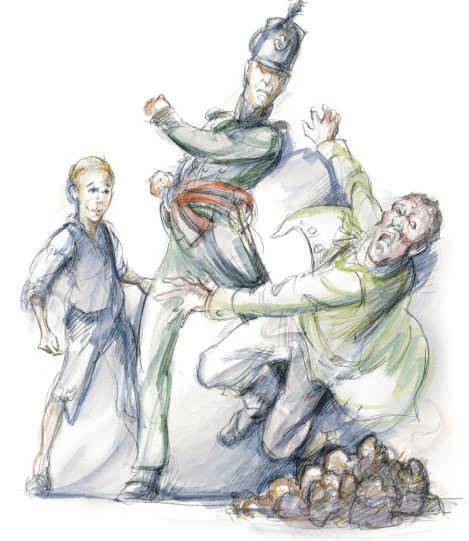
formed part of his clothing issue. The forage cap was made of black cloth with white edging and ‘95’ embroidered in white thread.
One item was detested by all of King George’s men: the black leather stock. It was a collar of stiff black leather designed to maintain the neck at the correct angle for good military posture and bearing. The men hated it, for it was rigid and its edges dug into the neck, causing sores and welts.
Many of the necessaries were designed for cleaning and tidying, such as a clothes brush, three shoe brushes, two combs, oil and emery paper. Necessaries were kept in a knapsack. When in barracks or the depot, everything had to be kept in a particular way. A rifleman had to fold his mattress and bedding neatly. A rifleman and his kit were inspected daily. If any item was found to be damaged or missing, the rifleman would have his pay docked by the value of the items damaged or lost.
If a rifleman lost his clothes brush, he was stopped 6 pence. If he damaged a shoe brush, he was stopped 5 pence. A misplaced shirt would see 5 shillings and 6 pence withheld which, considering that a day’s pay was 1 shilling, was no small amount. Soldiers quickly learned that the Army accounted for everything and few
What did the bugle mean to troops during the Napoleonic wars? An orphan joins a crack British regiment and finds out Stephen Petty
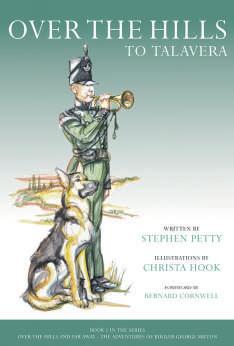
EDITOR’S NOTE
So much of what was commonplace in the past is now not just unfamiliar but beyond our comprehension. The use of children in war is one example. Fictional but plausible George Milton is only a boy when he joins the 95th Rifles in the early 1800s but boys younger than him served as powder-monkeys on Royal Navy ships and a five-year-old girl tore up lint and helped bandage the wounded at the battle of Waterloo. In this educational story, George becomes one of the most valued soldiers in his regiment, not as a rifleman but as a bugler. It’s a far cry from drone attacks. NB: Profits from the sale of this book will be donated to the Rifles’ Regimental Charities.
were adorned with wings of black cloth. He was also given a shako made of black felt and leather with a bugle horn cap badge, cords and tufts of green.
By far the largest amount and variety of kit and equipment were those items known in the Army as ‘necessaries’. It was impressed upon George that the Army would hold him personally liable should any item be lost or damaged. George’s necessaries included a turn screw, brush and worm to help keep the flintlock firing mechanism of a Baker Rifle in perfect working order. Three shirts, three pairs of socks and a forage cap
would ever get off scot free.
George was quick to learn. He did this by watching how the experienced riflemen went about their daily routine. He was also very fortunate that his chosen comrade, Rifleman Cooke, was a first-class soldier of fine character who set an excellent example and offered George guidance whenever it was needed.
At first, George was taught the basic elements of drill. Alongside the other new recruits, George spent two intense hours each day on the parade ground under the orders of the Drill Sergeant. George was to find out very quickly that Drill Sergeants knew everything and missed nothing. He had no wish whatsoever to be on the receiving end of a reprimand from the Drill Sergeant and he dreaded being sent to join the Awkward Squad, the shame of which would be impossible to live down.
Recruits who struggled to follow the barked commands were sent to drill with the Awkward Squad. A recruit was not permitted to wear full uniform or be instructed in Rifle Drill until he had perfected the drill movements. A recruit had twenty-two basic movements to memorise before progressing to Firearms Drill.
Instructors needed an instant response from their recruits to the voice of command. Indeed, clear lines of communications were vital to survival on the battlefield. Rifle battalions were set up and trained to operate by companies or platoons so they needed well-drilled and disciplined soldiers who could act independently when it was needed. The Rifles wanted soldiers who could think for themselves and act quickly. When acting as skirmishers, riflemen fought in pairs, each man depending on his partner. Training had to reflect that requirement and, unlike almost all other regiments in the British army, the 95th prided themselves on their ability to think for themselves.
From Bedales to the Boche is a beautifully written First World War memoir, with evocative material about the life of two soldiers—brothers from Birmingham, born in the 1890s, sent to the experimental coeducational Bedales boarding school in Hampshire, and then trained at art college in Düsseldorf.
Robert (Bob) and Frank Best had planned to become music-hall entertainers, in the mould of George and Weedon Grossmith of a generation earlier, and this account is strong on period detail about the comedy culture of the George Robey years.
But instead of realising their dreams, the brothers ended up enlisting in the army on the outbreak of war, serving with the Army Service Corps in northern France and then Dublin (to help quell the 1916 Easter Rising) before, in a rush of schoolboyish enthusiasm, fulfilling a long-held dream and joining the Royal Flying Corps, learning flying and gunnery at Oxford, Thetford, Dover, Turnberry and Wyton before being posted to a squadron at the R.F.C. training school in Vendôme.
Both brothers could have become high achievers in the performing arts after the war but Robert returned to Birmingham to work in the family metalworking business. Having learnt the craft of a metalwork designer before the war, he became interested in how design was evolving in Germany and how new thinking could be incorporated into the work of his father’s firm, Best & Lloyd. He went on to design the Bestlite, an iconic Bauhaus-styled desk lamp used by Winston Churchill, and built up the firm into one of the largest lighting manufacturers in the world, traveling to the USA to win contracts, maintaining his father’s showroom in Paris and supplying light fittings to hotels, ocean liners, cinemas and town halls internationally.
Best was actively involved with the Design and Industries Association and other artistic bodies set up to improve aesthetics, working practices and apprentice education, both nationally and in the Midlands. Tormented by a nervous speaking ailment, he became an early disciple of the Australian posture therapist and health guru F.M. Alexander, sponsoring an expansion of Alexander’s activities into the Midlands but later criticising him for his artistic and personal insensitivities. He helped to co-found Common Wealth, an egalitarian cooperative political party that sat uncomfortably between the Labour and Liberal parties. He married twice.
After retiring in the 1960s Robert Best committed himself to writing a partly biographical, partly autobiographical account of the early 1900s, dedicated to and built around the life of Frank, his younger brother. Printed in two volumes and circulated in a limited edition of 200 comb-bound photocopies in 1969, the book was originally titled A Short Life and a Gay One
Its scope is enormous. The two boys had been immensely energetic and talented, and the book documents in compelling and convincing detail their many interests and activities. As small children at home they had drawn cartoon strips about the Boer War, learnt the piano and performed in home entertainments of their
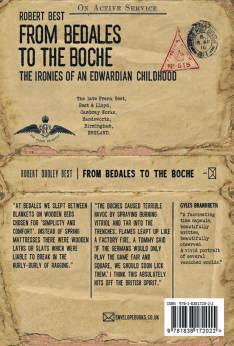
own devising. Their talent for performance developed further at Bedales, where they were part of a tight-knit group of school humorists, parodying school celebrities and the musical and political events of the day, on stage and in the Bedales Chronicle
Though irreverent, Bob and Frank took seriously the spirit of open inquiry and self-education—‘the will to fuller life’— fostered by Bedales’s founding headmaster John Haden Badley. Much of what was studied in class was taken further after hours when the boys carried out experiments of their own into acoustics, aeronautics, acceleration, optics, photography and subsoil temperatures, amusing themselves but learning at the same time. To the credit of the school, there was little distinction between work and play. Frank and his friend Peter Eckersley toyed with improvised radio transmitters in a hut in the school grounds; a decade and a half later, Eckersley would become the BBC’s first Chief Engineer.
Thus, whatever else Frank was engaged with, his school career was one of immense promise and abundant energy. Through him we learn about the novelty of new music, both popular and serious, about the relative merits of different music-hall entertainers of the day, and about what made his contemporaries laugh. His love of gadgets and new technology translated after school into a fascination with motorcycles and cars. A ‘young buck’, the world he aspired to was one of theatre-land, well-made clothes, flirtations and high spirits.
From the account of Frank’s time in Düsseldorf in 1913 and of Robert’s the previous year, we learn about the wide cultural differences that still existed between Germany and Britain. Of particular interest are the descriptions of attending local performances of operas by Wagner (Parsifal could not be performed outside Bayreuth until the end of 1913, 30 years after Wagner’s death), of the tedious repetition of ‘Stille Nacht, heilige Nacht’ (‘Silent Night’)—still unknown in England—at Christmas, of unpleasant German medical procedures, of the excessive militarism of the Germans, of the last flowering of pre-Bauhaus art-school teaching, and of the unhappiness of German schoolchildren and the incidence of Easter suicides among those not promoted to the next class.
The prevailing mood of the brothers’ contemporary writings is one of engagement and excitement. Even in the material that he wrote after retiring in the 1960s, Robert maintained a spirit of positivism at odds with his own day’s distrust. His title—A Short Life and a Gay One—was taken from the comic song ‘I’ve gotter motter—always merry and bright’, from the popular 1909 musical comedy The Arcadians, which would have been familiar to everyone of his generation. The ‘motter’, in the context of how the book ends, is indicative of a refusal to be beaten that typifies its age. Not only did Robert read this spirit into his brother’s sensibility, he adopted it himself 50 years later. This was in spite of his immersion in radical liberal politics in the intervening years and in spite of the anger and accusation that had come to frame attitudes to war in general and the Great War in particular—attitudes we now asso-
It’s war. Two brothers destined for musical comedy sign up for the Royal Flying Corps. Life expectancy: just a few weeks Robert Dudley Best
EDITOR’S NOTE
Robert Best absorbed everything around him. He was inspired by his headmaster, J.H. Badley, at Bedales School, and by the comic poetry and music of the period, and by the era’s fascination with manned flight. and by father’s interest in design education, and by Walter Gropius, whom he hosted on Gropius’s first visit to the Midlands in 1935, and by F.M. Alexander, the inventor of postural therapy. As Gyles Brandreth—a younger Bedalian—has said, Best’s early memoir makes ‘a fascinating time capsule, beautifully written, beautifully observed—a vivid portrait of several vanished worlds.’ It is also the memoir of a human sponge.
ciate with works such as Joan Littlewood’s Oh, What a Lovely War! which came out in 1963, four years before Robert completed A Short Life and a Gay One
Of interest to today’s social historian is the compulsion of both brothers to take note of everything around them at the time and Robert’s subsequent concern to take those notes seriously, making From Bedales to the Boche a valuable sociological study. Quotations from diaries and letters provide surprising insights into the language of the time. We learn, for example, that as early as 1915, the English were using the word ‘dough’ to mean money: it was not a later borrowing from Hollywood. We get chapter and verse on the new dances that were coming in, what was played on portable Deccaphones in the drawing room, and of the etiquette of social life. We get glimpses of the popular literature of the day and even, through Frank, of the emerging movie industry in Paris.
In respect of the war, what strikes today’s reader at the start of the book is how indispensable the horse was and yet how casually horses were dispensed with. The A.S.C.’s ability to keep troops supplied depended on the horse and yet repeatedly in Frank’s diary entries we read:
Passed dead horse at bottom of first hill from another company, shot by vet.
Got up for stables before breakfast and took our vet round the lines. Horse No. 3 had died in stable in early hours of morning. During breakfast time I went round still helping to adjust loads and wagons in cold snow and rain. Horses looked much better for rest generally, but No. l turned much worse and eventually had to be shot. One other died in the Headquarters Company.
Another horse died during the night, probably through undue exhaustion, etc.
This contrasts markedly with the care and respect given to aeroplane engines and guns in the Royal Flying Corps, which Bob and Frank joined in December 1916 in the hope of a more flamboyant military existence. Pilots had to have a detailed understanding of their machines because their lives depended on it. Machine guns ‘were inclined to jam, lock, and suddenly cease to function,’ wrote Robert. ‘Nothing could be more exasperating than to get the enemy machine nicely into the ring-sight, press the trigger—and then—after perhaps a short burst—silence ... We were shown, again and again, how to free these “stoppages”.’ They were also shown how to strip down and rebuild an engine, how to creep up on an enemy plane unseen, how to go into and get out of a spin, what to do if their engine failed while flying in formation, and how to communicate with other pilots while in the air:
While in some machines Morse messages could be sent to the ground by wireless there was no telephony between the machines. Communication was made by certain signals, rocking the wings, and so forth. If your gun jammed, you were to catch up with the leader and rock the machine fore and aft. Coloured ‘Verey’s Lights’ (fireworks discharged from a pistol) were supposed to indicate that the pilot was going home, in cases of engine failure. A rendezvous continued in the book
FROM BEDALES
Softback, 428 pages 9781838172022
RRP £14.75
Our price £11.99
READERS’ COMMENTS
To comment on this book, email your thoughts to book@booklaunch.london
We welcome either written responses or MP3 voice tracks. All contributions are moderated. Our online Comment page will launch in the Spring. Subscribe now and we’ll send you an alert when it’s up and running.
RRP £20.50
How mobile phones brought money and trade to places the banks could not reach Sanjeev Gupta, Michael Keen, Alpa Shah, Genevieve Verdier
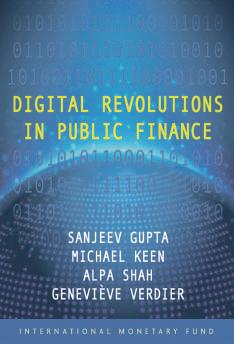
Tax authorities are increasingly gaining access to the vast amount of information held by the private sector—such as data on bank transactions and interest income—through the use of digital systems, standardized reporting formats, and electronic interfaces. Governments can now collect more timely information. Tax authorities in Australia and the United Kingdom are now receiving real-time reporting of payoll information, and, in Brazil and Russia, electronic invoicing systems allow immediate access to data on firm sales. A number of governments can now access high-frequency fiscal data through their information technology systems. Some countries—such as Brazil and the United States—even make these daily cash operations available to the public.
Digitalization also allows for more precise identification of individuals and their associated activities. New technology to monitor and record biometric characteristics provides a unique, secure and less-costly alternative to more traditional paper-based official documentation systems.
In many developing countries, this technology has given governments and citizens the means to authenticate official identity, strengthening civil registries and
READERS’ COMMENTS
To comment on this book, email your thoughts to book@booklaunch.london
We welcome either written responses or MP3 voice tracks. All contributions are moderated. Our online Comment page will launch in the Spring. Subscribe now and we’ll send you an alert when it’s up and running.
national ID card systems using various physical traits, including fingerprints, iris scans, vein patterns and DNA. Latin America leads the way in biometric-enabled national identity systems, but other regions are not far behind. Africa, Angola, Ghana, Nigeria and South Africa have established or are planning such systems. Countries in South Asia such as Afghanistan, Bangladesh, Nepal and Pakistan are following suit. India’s Aadhaar is the world’s largest biometric identification system, with more than 1.1 billion citizens registered.
Case Study 1: Kenya
Kenya has been among the success stories, leading the way with a mobile-phone-based financial services platform, set in motion by the inception of the M-Pesa, a money-transfer system that gradually advanced into realtime retail payments and further into a virtual savings and credit supply platform. These innovations have led to a broad retail payment platform, which has made payments more efficient, transparent and safe, regardless of income level. The broader platform has been useful for functions including e-commerce, tax payments, and revenue administration. Digitalization has also begun to change the way fiscal policy works, with the March 2017 launch of M-Akiba for micro-investment in government securities using the mobile-phone platform.
M-Pesa (‘mobile-money’) was launched in March 2007 as a bank product in partnership with Safaricom, a telecommunication company, and the Commercial Bank of Africa, a commercial bank in Kenya. M-Pesa enabled users to store value on their mobile phone or mobile account as electronic currency for multiple uses, including transfers to other users, payments for goods and services, and conversion to and from cash.
The structure of M-Pesa was based on a person-to-per-
son money transfer system that enabled millions of Kenyans to use the M-Pesa platform to make payments and send remittances. Safaricom supervised and regulated its network of agents, who formed the pointof-service countrywide, and another class of agents, the aggregators, who ensured efficient, effective and transparent liquidity distribution across the country.
Funds were held in a trust account with the Commercial Bank of Africa that formed the transaction platform. Safaricom issued electronic money in exchange for cash at par value, and this was stored in the SIM card for the customer and simultaneously loaded into the trust account at the Commercial Bank of Africa. The trust account was under the custody of trustees, its funds separated from Safaricom business account funds, meaning that Safaricom could not access them.
Trust accounts became the payments system platform in commercial banks, separating regulatory issues for banks from those of telecommunication companies. This gave the market confidence that cash and transactions were secure.
The M-Pesa platform quickly developed into a platform for payments of goods and services and subsequently to mobile-banking functions.
EDITOR’S NOTE
through third-party sharing of information. Currently, the iTax system is already integrated with the Integrated Financial Management Information System and Central Bank of Kenya and plans are under way to integrate with other systems such as the National Social Security Fund National Health Insurance Fund, and the eCitizen digital platform. This integration will facilitate identification of potential tax defaulters, unregistered businesses and individuals, and increase active taxpayers and tax compliance.
Most developing countries have narrow tax bases owing to many factors, but one clear reason is their large informal markets. In this area, the Digital Financial System is expected to play a major role in helping to formalize informal enterprises and to expand countries’ tax bases. Formalisation here does not automatically mean that these informal businesses will be registered. But bringing transactions onto the formal platform will allow the government to design incentives to formalise all aspects of such informal businesses.
Case Study Two: India
By February 2017, more than 1.16 billion Indians had subscribed to mobile services, for a ‘mobile teleden-
In 2009, when the Afghan government started paying salaries digitally, police officers thought they had been overpaid. Some thought this was an error; others assumed it was an unexpected pay rise. In fact, the officers were getting what they had always been due but without superior officers and clerks skimming their payrolls—for the first time. This IMF book documents the impact of digital payment systems on some of the poorest in the world and grows out of a conference funded, as the book is, by the Bill and Melinda Gates Foundation. Available in the UK from Eurospan: www.eurospanbookstore.com. Find other IMF titles at www.imf.org/pubs
Financial access touch points in Kenya have also continued to expand, with more bank branches, ATMs, telecommunication agents, and an agency network for banks. About 76.7 per cent of Kenyans are within five kilometers of financial access points, compared with 35.1 per cent of Tanzanians, 42.7 per cent of Ugandans, and 47.3 per cent of Nigerians.
Prior to 2013, the Kenya Revenue Authority mainly relied on the Integrated Tax Management System for domestic tax administration. But with further developments in that system and the launch of iTax, the profile of taxation and tax payments has changed.
The iTax is a user-friendly, web-enabled, secure application that provides fully integrated and automated administration of all domestic taxes. It allows the taxpayer to register, file, pay and inquire about status online with real-time monitoring of accounts. The system confirms successful registration, electronic filing and actual tax payment. It also enables online back-office processing of all Domestic Tax Department transactions. Access is restricted based on the different tax categories.
The iTax system registers taxpayers based on a unique personal identification number (PIN) acquired through the system. Once registered, a taxpayer account is created that forms the core of the iTax system through its comprehensive information about all taxpayer activities.
In October 2014, the KRA launched the KRA M-Service platform, a mobile phone application that facilitates tax payment and taxpayers’ access to tax information.
The iTax system and KRA M-Service have revolutionized tax design and payment, and revenue administration in Kenya through digitalisation.
Digitalization has given the KRA an opportunity to strengthen and revamp its tax enforcement mechanisms
sity’ of 85.9. Teledensity has risen as much as tenfold in slightly more than a decade and prices of mobile services have fallen sharply. By February, 261 million people had become broadband subscribers, up from 1.4 million in March 2006.
Several government projects are catalyzing this digitalization. Among them, a national biometric identity program (Aadhaar) has reached about 1.15 billion residents, and enables identification and authentication of residents. In banking, two programmes are helping bring the ‘unbanked’ into the economy. And under the Pradhan Mantri Jan Dhan Yojana of August 2014, more than 280 million bank accounts had been opened by March 2017, while another 243 million accounts were opened under a government financial inclusion plan before this. Many of these accounts are held by people who never had bank accounts before, while about 60 percent of the Pradhan Mantri Jan Dhan Yojana accounts were opened in rural areas.
Banking and payments are also undergoing considerable change. Following the demonetization of its 500 and 1,000 rupee (Rs) notes in November 2016, the government announced several measures to increase the pace of digitalization of storage of value and payments. It has reduced the maximum value of cash transactions, lowered permissible cash donations to political parties, and announced various incentives for making electronic payments, such as a service tax waiver for certain values of digital payments.
In addition, it waived transaction charges for digital payments made to government agencies and offered discounts and rewards for making digital payments. The Reserve Bank of India also relaxed customer charges for various modes of digital payment.
Yet despite a widespread perception of India
The history of the history of modern British intelligence began in 1917. However, the postGreat War history of the intelligence services was notably shallow and lacking in detail. Few in power asked any serious questions about military, air, or naval intelligence after the conflict was done. When the post-Second World War secret historians tried to find out about intelligence in the First World War, they struggled to discover anything other than ‘bare bones’.
First-World-War-era politicians and senior civil servants were fascinated by the internal conflicts among the civilian intelligence agencies: MI1c, the Foreign Section of the Secret Service Bureau; MI5; Scotland Yard; Indian Political Intelligence; and the Government Code and Cypher School (GC&CS). In 1919, when the First Lord of the Admiralty, Walter Long, pushed for a reorganization of the intelligence state and the creation of an overall Director of Intelligence, he specifically ruled out detailed discussion of military and naval intelligence on the grounds that ‘it is on the civilian side that there is an entire absence of authority to act.’
The Prime Minister’s Secret Service Committee commissioned ‘mini-histories’ of eight intelligence services: ‘the Secret Service’, ‘Contre-espionage’ [sic], naval intel-
Ball
ligence, military intelligence, air intelligence, war trade intelligence, Indian intelligence, and intelligence in Ireland. The members of the committee had these histories before them when they first met in February 1919 but learnt relatively little from any of them.
This lack of sustained reflection on intelligence within the state helped to create the conditions for a boom in intelligence war books written as tales of personal exploits, without an underpinning analysis of either truth or relative significance. Scotland Yard’s Basil Thomson, whose area was counter-subversion and counter-revolution, predicted this would happen as early as April 1918. The ‘confessions of spies’ were inevitable and would be, inevitably, unsatisfactory. As he wrote in a review of one such title, such books were ‘the most unsatisfactory of all documents: fiction masquerading as truth’.
In the aftermath of the First World War, classified histories of intelligence were written, but were dusty and dry as well as confused and unrevealing. There was no appreciable rise in the status of intelligence officers. The official historian of the Great War, Sir James Edmonds, had in fact been an exceptionally influential pre-war, military intelligence officer. However, the Committee of Imperial Defence’s monumental history of the First World War that he oversaw stressed the importance of military operations rather than military intelligence.
In his more personal role as an anonymous reviewer for the Times Literary Supplement, Edmonds wrote over 400 reviews of war books. Only four of those reviews concerned military intelligence, three being hatchet jobs on the work of Colonel Walter Nicolai, the head of the German army’s intelligence agency, OHL III.B. Edmonds’s output was representative: intelligence was a minor key in the history of the war.
The history of British military intelligence produced
EDITOR’S NOTE
by the War Office in 1921 was almost wholly an organizational narrative. In November 1917, the controlling section of the Directorate of Military Intelligence (DMI), MI1, had formed a small unit to write histories for the directorate. Within three months, the unit was transferred out of MI1, because its work was not about the history of intelligence but a compilation of what military intelligence had learned about other countries. In September 1918, Sir William Thwaites became the final wartime Director of Military Intelligence. He assigned one officer on his staff, Major Potts, the task of writing a history of British wartime intelligence. Potts merely solicited reports from each section head and compiled them into a narrative.
The history of GHQIB, the secret intelligence service of the British Expeditionary Force in France and Flanders, made it nearly impossible for a reader to understand what had happened, unless that reader had been personally involved. Apart from an interminable account of pigeon usage, the main ‘case history’ concerned the setting up of a GHQ secret service in Switzerland and Luxembourg toward the conclusion of the war. In the end, with much study, the reader could have worked out that GHQ secret intelligence boiled
in the lessons underlying the history he had commissioned. Immediately after the war, Thwaites had intended to merge the Sub-Directorate of Special Intelligence in the DMI with C to create a proper military secret service, a ‘Special Intelligence Service’. He had also suggested, as a smaller subsidiary initiative, the merger of the cryptographic intelligence services of the army and the navy.
The timing and direction of Thwaites’s thinking was important. His vision of integrated intelligence explains why he had been so supportive of C in the spring of 1919. Thwaites’s historians—with actual experience of intelligence during the war—were much less sanguine about C. The history that Thwaites eventually put his name to—essentially completed by the end of 1920, and promulgated in spring 1921—was much more cautious about the integration of intelligence.
C had powerful patrons on the civil side. Thanks to the repeated interventions of Lord Hardinge, the permanent under-secretary of the Foreign Office, Thwaites’s plan for military intelligence had been stymied. Hardinge argued that, ‘all things considered [the civilian Secret Service] has survived the war with fair measure of success.’ Hardinge offered no sustained
SECRET HISTORY WRITING THE RISE OF BRITAIN’S INTELLIGENCE SERVICES

McGill-Queen’s University Press Softback, 272pp
16 April 2020
9780228000822
RRP £21.95
Our price £18.99
down to one main activity: train watching. It believed it had had about 6,000 agents.
The reader could gain no insight from the history about why what had happened in military intelligence happened. Only careful reading would reveal the overall goal of these historical efforts: incorporation into a planned post-war Manual of Military Intelligence. The history of military intelligence in the First World War was an exercise in very limited and narrow ambition.
In April 1922, Military Intelligence was merged once again with Military Operations. The Military Intelligence sub-directorate would publish two things in the entire interwar period: The Manual of Military Intelligence in 1923 and its revision in 1939. All the interesting findings were placed in a ‘secret supplement’. The secret supplement began with a firm statement of what the army learned during the war of ‘1914–1919’. The most valuable military intelligence had been ‘acquired by the studying of the signals communications of armies in the field’. Some 43 percent of intelligence successes in the First World War were attributable to so-called ‘Y’ Intelligence.
‘Secret Service’ in the sense of human intelligencegathering through agents was, however, important, if properly integrated into the military machine. In the words of the Manual, Secret Service was ‘not a thing apart’. It was ‘merely the complement of other intelligence organizations and never likely to achieve success unless employed in closest conjunction with the latter.’ The Manual paraphrased the history of GHQIB in mocking the idea that a line on the map could be drawn between military intelligence—operating near the battlefield—and ‘C,’ operating further back. Indeed, much of the secret supplement was derived directly from the GHQIB history of 1919.
William Thwaites was most definitely interested
When the wizards of Whitehall were asked to document their own work a century ago, the results were paltry. Reports covered up more than they revealed, partly because of interdepartmental rivalries, partly out of a fear that revelation might expose vulnerabilities. In this richly researched study Simon Ball surmises that intelligence chiefs may also not have had a strong grip on what their various operatives were doing, or any strategy that gave their work direction or coherence. Then came the novelists, from Buchan to Fleming to le Carré, who gave the subject of Intelligence a fresh take that fed back into its own accounts of itself. Fascinating.
evidence for his contention.
In 1919, William Thwaites’s smaller initiative to create a single cryptographic agency had gone ahead, to the eventual disadvantage of the army, who lost control of cryptography.
Malcom Hay, the head of War Office cryptography, felt that Thwaites had sold the pass, and left military intelligence in a rage in the summer of 1919. As a result, the history of military cryptography was almost entirely lost. Hay had commissioned a five-page history of his unit, but there is no evidence that it was ever passed on to a higher authority or informed either the history of Military Intelligence or the Manual of Military Intelligence. MI1b, MI1e and MI1d—the cryptographic bureaux—were thus destined to become ‘the worst documented of British intelligence agencies between 1900 and 1945’.
These bureaux had been manned by army subalterns classified as unfit for active military service. Their recruits had had low status in the army hierarchy, but that did not mean that they had been ineffective. The secret history claimed that, by the end of 1917, they had been deciphering ‘all long-range wireless messages emanating from Germany’. The bureaux had developed a sophisticated network for sharing their intelligence with GHQ and, subsequently, with the Americans. There is every reason to believe that they were appreciated in their own time: the bureaux left little trace.
In 1926, when a new military interception and cryptography station was started, it felt like a new creation, not a re-formation. Military Intelligence Y in the Second World War traced its lineal descent to the 1920s, when the War Office set up a centre in Chatham, not to the First World War bureaux with offices in Cork Street, London.
continued in the book
READERS’ COMMENTS
To comment on this book, email your thoughts to book@booklaunch.london
We welcome either written responses or MP3 voice tracks. All contributions are moderated. Our online Comment page will launch in the Spring. Subscribe now and we’ll send you an alert when it’s up and running.
In WW1, Number 10 asked the heads of civilian intelligence what they were up to. No one was prepared to say. Or able to Simon
The first Monday of the month approached. My ‘antique’ Service revolver was oiled and ready. Holmes and I planned our trek in every detail. Old Roar Waterfall was known to me only through a sketch a century earlier by the landscape painter, J.M.W. Turner, now at the Tate Gallery. The chalk and graphite depiction portrayed a wild gully set in a deeply cut, narrow, wooded valley above the isolated fishing village of Hastings. The gully enjoyed the clime and dense plant life of a tropical jungle, home to rare orchids, bird and insect species. There was only one path to the falls, through terrain ideal for an ambuscade. Our foe Moran, as author of Heavy Game of the Western Himalayas and Three Months in the Jungle, was no stranger to ambuscades. A hunter of iron nerve, he had once crawled down a drain after a wounded man-eating tiger.
The stakes were high. Moran notoriously never played by the Englishman’s unspoken rule of giving the other side a sporting chance. This time, neither would we. We would follow the diktat of natural justice. Soon Colonel Sebastian Moran would trouble us no more.
So engrossed were we with our preparations that it did not strike us for an instant that Moran’s challenge was a hoodwink. The deliberate mockery of my trusty Service revolver, the goading tone, the almost nostalgic choice of setting, echoing the far mightier, more majestic Reichenbach in the Swiss Alps. But as it transpired, Moran had no intention of facing us at Old Roar Waterfall. He was putting in place a plan as devilish as human wit could devise.
When Lestrade of the Yard apprised us of Sebastian Moran’s hideaway, he mentioned en passant how the Colonel had taken up raising bees. I dismissed this curious fact as mere coincidence and forgot all about it. But Kismet was to intervene. I had just left the Club’s handsome dining-room for the reading-room and was drifting into a nap behind a copy of the Times when an apparition from my long-gone days in Afghanistan appeared at my elbow.
‘Why, it’s Watson, isn’t it?’ a voice exclaimed. ‘Blow me down! Do you recognise me?’
For a moment I struggled to determine whether the figure was real or a figment of reverie until he leaned forward and clapped me on the shoulder. How could I forget! Surgeon-Major Alexander Preston had been with me in the thick of the Battle of Maiwand. His experience, gained through an earlier stint in the Crimea, served the Regiment well. Throughout the battle he bore himself with the traditional nonchalance of a British surgeon in a tight place, while all around our men were going down to a humiliating defeat.
We reminisced about old times. He recounted the events after I was wounded and removed from the field. Ayub Khan’s officer corps had been strengthened by the large number of Sepoys who fled to his side after the failure of the Indian Rebellion. Nevertheless, Preston sensed the enemy was losing morale despite their superior numbers, until the day was saved for Ayub by a young woman by the name of Malalai. Alarmed by her side’s mounting despair, she seized the Afghan flag and
READERS’ COMMENTS
To comment on this book, email your thoughts to book@booklaunch.london
We welcome either written responses or MP3 voice tracks. All contributions are moderated. Our online Comment page will launch in the Spring. Subscribe now and we’ll send you an alert when it’s up and running.
Can Colonel Moran succeed where the Napoleon of Crime failed and deprive the world of Sherlock Holmes’s life? Tim Symonds
rallied the Pashtuns to victory.
We reminisced further for a good while before I turned to the present and asked Preston where he was now practising medicine.
Using the Sanskrit for the Hindu Kush, he replied, ‘Not in the Pãriyãtra Parvata, I can tell you! I’m in the deepest English countryside. After my time in Army Medical Service, life in the most primitive village in England suits me completely. A few cottages huddled around the tiny church of the Blessed Virgin and St. John the Baptist. No telegraph office. Just the one telephone, at the Railway Arms. I deliver a few babies, treat the occasional marsh fever, even take out an appendix once in a while. The quietest place you can imagine.’
The Surgeon-Major paused.
‘Mark you, something did happen only a few days ago … never seen anything like it. He recounted how two sturdy walkers had decided to trek across the marshes three or four miles from his surgery. They ignored the “Keep Out” boards, holding that signs in the countryside did not apply to visitors from London.
‘Then something very curious and inexplicable took place,’ Preston continued. ‘The hikers were passing a cluster of abandoned maltings when a swarm of bees poured out like a sudden dark rain-cloud. Most bees are polite if you don’t disturb their nests. They don’t usually chase you. These bees did. They attacked the two poor blighters relentlessly.
‘In appearance, there was nothing exceptional about the bees. Possibly they were slightly smaller than our familiar black honeybee. I estimate they inflicted two thousand stings on each of their victims. A bee stinger is barbed, like a harpoon. When you consider a human can die with just a hundred stings …’
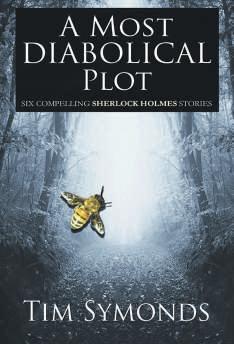
My narrator threw up his hands.
‘By the time the local farmer came to fetch me, there was nothing I could do. Both men died within minutes.’
He added, “The owner of the skeps must have worried the authorities would bring a charge of criminal negligence against him—as they should. That same night he upped sticks and disappeared, taking his bees with him.’
I sprang to my feet.
‘Tell me, Preston,’ I demanded, ‘where exactly do you have your practice? You say deepest countryside. Did this by any chance take place along the Stour, near a village by the name of Haddiscoe?’
My old Army comrade looked stunned.
‘Why, my old friend!’ he exclaimed, ‘you seem to have developed psychic powers! Heavens above, you’ll be excreting ectoplasm next. That’s exactly where the incident took place.’
My blood chilled. All was now clear. The invitation to a showdown at the Old Roar Waterfall was a red herring, designed to engineer Holmes’s absence from his orderly rows of hives. From his Stour Valley remoteness, our enemy had hatched the most deadly plot ever devised against us. While we crept our way through the undergrowth to the waterfall, Moran would be on the Downs preparing a deadly trap for us. He would switch
EDITOR’S NOTE
Holmes’s tractable apis mellifera mellifera, at home in Britain since the last Ice Age, for the breed of hideously dangerous African bees which stung the unfortunate London visitors to death.
Holmes was known to walk between his rows of hives without veil or gloves. The moment we returned from our futile trek to the waterfall, we would suffer the same fate as the hikers on the Suffolk marshes. The postcard of the Sussex cricketer K.S. Ranjitsinhji in Moran’s rented farmhouse indicated Moran had already reconnoitred the area. At this very moment, he and his deadly skeps might be within striking distance of Holmes’s own bee- yard, tucked away in secondary woodland which had quickly recolonized my comrade’s sheep-free land. I bid a rapid goodbye to my Regimental friend and hurried off to find a telephone, muttering to myself on the way, ‘Moran, you cunning, cunning fiend!’
Inspector Lestrade was often out of his depth but on this occasion he became a man of action and authority. He pointed out that Moran would have his henchmen watching our every move. The Colonel would unfold his plot only if he was assured we were well away from the bee-farm. One glimpse of our presence on Holmes’s bee-farm on the day and the effort to catch Moran in flagrante and kill or return him to gaol would fail. Lestrade ordered us to continue with our established plan. He telegraphed Tobias Gregson, the policeman who was keeping an eye on Holmes’s bee-farm, to ask him to make rapid enquiries. Gregson replied the same day. Mysterious lights, more often seen over graveyards, had been spotted at Holmes’s Hodcombe Farm, prompting rumours of will-o’-the-wisps. Locals were giving the spot a wide berth.
Our departure for Hastings would be as conspicuous as possible. In the meantime, Lestrade, Gregson and a dozen armed police set up their trap. They would lie in wait on the Downs. If Moran surrendered, our foe would be returned to gaol to serve out the remainder of his sentence. If he resisted … every one of Lestrade’s squad was a marksman.
On the Monday, Holmes and I took the train to Hastings. We made our way to Old Roar Waterfall on foot and set about constructing two hides in the heavy undergrowth. 2 p.m., the appointed time for our dénouement with Moran, came and went. We set off on the return journey to the bee-farm, eager to learn the outcome. Several police marksmen lay at ease, spreadeagled among the bushes. Lestrade was pacing up and down on Holmes’s veranda, staring out across the Downs. It was clear from the Inspector’s demeanour he was not relishing our return. Something had gone badly wrong.
We were a cricket pitch’s length from the house when a shaken Lestrade turned and came hurrying towards us, ashen-faced. He stopped short, calling out, ‘It’s no good your scowling, Mr. Holmes. We did our best. This time Moran was just too tricky for us.’
With a heavy shudder he cried, ‘He was there, right in front of us, and then he wasn’t. It was as though he possessed some supernatural power!’
Bitterly disappointed, I turned to console my continued in the book
There is almost as much of a Sherlock Holmes cult today as there was when the Great Detective was still a novelty. Holmes’s death at the Reichenbach Falls in 1893 turned what had been an obscure Swiss waterfall into a place of pilgrimmage, and a suicide watch had to be manned to stop distraught fans from following ‘the Master’ into the chasm. The focal point for today’s fans is MX Publishing, which has more than 400 new Holmes adventures in its catalogue and has nurtured over 100 authors. One of the best is Tim Symonds, who specialises in bold pacing and meticulous period detail. Read him also in Booklaunch 6, page 7.
Conan Doyle’s ‘A Case of Identity’ (1891) opens, like so many stories in the Sherlock Holmes saga, in 221b Baker Street, where Holmes and Dr Watson receive a new client who bears a problem that is also a story. Watson is both Holmes’s pupil in the science of detection and, crucially, the story’s narrator.
However, in this instance as in many others, Watson is a conventional but somewhat limited narrator— he reports accurately enough, but also superficially. Holmes sees beyond his visitor’s appearance and detects her uniqueness as a human being: she is ‘an interesting study … more interesting than her little problem, which, by the way, is rather a trite one’.
Her problem, of course, turns out to be anything but trite but Holmes’s message is that no one is as ordinary as they might appear. Put on the spot by Holmes, Watson succeeds in identifying only the outward and obvious features of her appearance, particularly the colours and cuts of her apparel. Holmes’s response is crushing: ‘It is true that you have missed everything of importance, but you have hit upon the method.’ Holmes upbraids Watson for failing ‘to realize the importance of sleeves, the suggestiveness of thumb-nails, or the great issues that may hang from a bootlace’. ‘You appear to
‘The Adventure of The Red Circle’ (1911), the ‘smallest point may be the most essential’. And yet there are other details in the narratives which escape incorporation into the plot but which remain obstinately present and frequently unexplained.
Holmes, we should remember, also acts as a narrator, reporting to Watson his activities and deductions. In ‘A Scandal in Bohemia’ (1891), for instance, he tells Watson in some detail how he carried out surveillance of Irene Adler in disguise, what he discovered and how he became an accidental witness at her wedding. In ‘The Adventure of the Gloria Scott’ and ‘The Adventure of the Musgrave Ritual’ (both 1893), Holmes digs out old cases from his archive and retells them to Watson. But some of Holmes’s accounts are highly problematic, including a strikingly contradictory account of his first meeting with Professor Moriarty in ‘The Adventure of the Final Problem’ (1893).
More generally, Holmes may be infinitely more perceptive than Watson but he is also—often by his own admission—rather less honest. In addition to adopting disguises and false identities, gaining entry to premises through subterfuge, and obtaining information through trickery, Holmes is capable of spinning elaborate fic-
‘still involved in some mystery,’ we are almost inclined to suspect that the affair concealed something else which the detective had failed to penetrate.
Wilson had earlier assumed in his essay that the errors and loose ends of the Holmes stories can be attributed to Conan Doyle’s carelessness in writing what Wilson considered to be superior potboilers, but here he acknowledges that more may be going on beneath the surface. ‘The Greek Interpreter’ is a good example of a story with numerous minor puzzles in which much is left open: the villains Harold Latimer and Wilson Kemp escape from their sinister house, taking their victim (Sophy Kratides) with them; months later Latimer and Kemp are found stabbed to death in Budapest, apparently after a fight, although Holmes appears to surmise that Sophy has had her revenge. But even this is expressed by Watson in a curiously provisional mode: ‘Holmes, however, is, I fancy, of a different way of thinking and he holds to this day that if one could find the Grecian girl one might learn how the wrongs of herself and her brother came to be avenged’. The story is indeed ‘still involved in some mystery’—but exactly what kind of mystery is left only partially disclosed. Some stories have become obscure not through
THE CASE OF SHERLOCK HOLMES SECRETS AND LIES IN CONAN DOYLE’S DETECTIVE FICTION

Edinburgh University Press Softback, 264pp
June 2020 9781474431309
RPP £19.99
Our price £14.99
READERS’ COMMENTS
EDITOR’S NOTE
As Penny Fielding points out in a review in Victorian Studies (Indiana University Press Volume 61, Number 4, Summer 2019), Glazzard, like Holmes, draws our attention to details we may have noticed but not paused to consider. Writing about ‘The Adventure of the Speckled Band’ (1892), Glazzard leaps from Dr. Grimesby Roylott’s murderous colonial background to the apparently mundane details of the family’s economic condition, spinning from Mrs. Stoner’s will a detailed appraisal of Roylott’s status as an inefficient member of the rentier class. Well worth reading for admirers of Holmes and of literary detection.
read a good deal upon her which is invisible to me,’ is Watson’s response. Holmes corrects him: ‘Not invisible, but unnoticed.’
The Case of Sherlock Holmes examines the ‘little things’ in the Holmes saga in order to detect stories that are present but which are concealed or obscured and which are, therefore, usually unnoticed. Some of these stories are implied but overlooked or not examined by Watson. Some are deliberately concealed by Holmes. Others are invisible to us because we have lost touch with the contemporary context that would have been familiar to Doyle’s readers. As ‘A Case of Identity’ exemplifies, Watson’s limited insight is one of Doyle’s principal techniques of obfuscation. Watson may not be wilfully mendacious but he frequently gets things wrong or overlooks them because, while he succeeds as a reporter, he fails as a reader
Holmes, by contrast, skilfully reads not only people but also objects, such as Watson’s watch in The Sign of Four or Dr Mortimer’s stick in The Hound of the Baskervilles (1902). He is also a careful and sophisticated reader of texts. In A Study in Scarlet (1887), for example, he correctly reads ‘Rache’, written in blood at the crime scene, as the German word for ‘revenge’ whereas the police assume it to be an abbreviated attempt to write ‘Rachel’; in ‘The Adventure of The Three Gables’ (1926) he unlocks the case through an interpretation of Douglas Maberley’s agonised prose and deduces from its inconsistent use of pronouns that it must be autobiographical.
What Holmes calls ‘the Science of Deduction’ is, then, a method of reading and one that Holmes implicitly teaches to the reader as well as to Watson. The ‘solutions’ that Holmes reveals almost invariably hinge on what appear to others as trivialities—as he says in
tions to save the reputations of others or to ensure that the public have a satisfactory explanation for disturbing events. In ‘The Adventure of the Speckled Band’ (1892), for example, he colludes with the authorities to ensure that Dr Grimesby Roylott’s death is recorded as accidental at the inquest—whereas Roylott was the victim of his own murderous plot (and with Holmes’s own actions contributing significantly to his death).
As Tzvetan Todorov has pointed out, the form of the detective story requires two stories: the story of the investigation (what narratologists call ‘subject’), told chronologically, and the story of the crime (the ‘fable’), told in reverse. ‘The Abbey Grange’, though, is more complex: it has two fables—the official solution (a burglary, a glass of wine, a violent death) and what we are told actually occurred (a love affair, a betrayal, an abusive relationship, a return, an accident).
‘Truth’ in the Holmes canon is multiple and variable, not fixed or absolute, and so stories multiply too. For this reason the sceptical reader is frequently dissatisfied by Holmes’s apparently definitive explanations.
This was noticed as early as 1945 by Edmund Wilson, who pointed out in a classic essay that the brilliantly surreal mise en scène of ‘The Adventure of the Greek Interpreter’ (1893) is insufficiently explained in the story’s conclusion:
[A] professional interpreter of Greek finds himself suddenly shanghaied in a cab and taken to a stuffy London house with velvet furniture, a high white marble mantelpiece and a suit of Japanese armour, where a man who wears glasses and has a giggling laugh compels him to put questions in Greek to a pale and emaciated captive, whose face is crisscrossed with sticking plaster. … The way of accounting for the sticking plaster seems, indeed, entirely unsatisfactory, and since Watson tells us that this ‘singular case’ is
To comment on this book, email your thoughts to book@booklaunch.london
We welcome either written responses or MP3 voice tracks. All contributions are moderated. Our online Comment page will launch in the Spring. Subscribe now and we’ll send you an alert when it’s up and running.
Doyle’s artistry, but simply because we do not tend to read them in their historical contexts, whereas Doyle’s first readers would have recognised their frames of reference. For example, Holmes and Watson make numerous forays into the world of the aristocracy and landed gentry, where they often encounter folly and sometimes find rampant criminality. In the late 19th and early 20th centuries, readers would have been more attuned to at least some of the symptoms of the enormous and fundamental changes going on in British society, in which landowners were largely replaced at the pinnacle of British politics and society by a new elite, enriched by manufacturing, commerce or financial speculation, and accompanied by a new segment of the middle class which derived status and income from professional services.
As this book will show, the Holmes saga narrates the fall of the aristocracy and the rise of the middle class in stories such as ‘The Speckled Band’, ‘The Musgrave Ritual’, ‘The Abbey Grange’, ‘The Adventure of the Priory School’ (1904) and ‘The Problem of Thor Bridge’ (1922). Similarly, today’s readers are likely to know less than Doyle’s contemporaries about divorce law reform, the shenanigans of the Prince of Wales who became King Edward VII, and the great national self-examination that followed Britain’s pyrrhic victory in the Second Boer War (1899–1902). All of these issues and many others are part of the texture of the Holmes saga, and this book aims to tease out these contexts, thereby showing the stories, to quite a surprising extent, to be socially and politically engaged.
When Holmes interprets and deciphers Douglas Maberley’s writing in ‘The Three Gables’, he is engaging in a literary-critical practice called ‘close reading’. Close reading—attending to the
continued in the book
‘Watson’s failing is that he sees but does not observe.’ Andrew Glazzard applies Holmes’s methods to literary sleuthwork Andrew Glazzard
Booklaunch
Booklaunch Literary Challenge No.4 “Relay Race” Set by Maggie Bawden
ASHBOURNE DERBYSHIRE ART APPRECIATION COURSE
A favourite game in our family involves making up name chains where the last surname becomes the next first name, thus Upton Sinclair Lewis Carroll Nye Bevan … or Leslie Stephen King Charles Kingsley Amis. I challenge you to produce the longest string, using famous names— or, if you prefer, literary works (This Side of Paradise Lost Horizon …). Want a harder challenge? Why not limit yourself to only male or only female writers, or see if your chain can lead back to where you started. to comp@booklaunch.london putting “Comp4” in the subject line and supplying your postal address, so we can send you a prize. Winning entries will be published.
Last issue’s winners: No.3 “Last Brexit to Ooklyn”
Study online Study when it suits
24/7 Student Support
Presented by Hilary Kay
Flexible Payment Options
Written by Leading Art Experts



www.conifercottage.biz holidays@conifercottage.biz
07779 722668

Well, this was fun. I asked you to choose two literary characters to debate the benefits of Brexit. First out of the slips was Catherine Miller from Wantage who opened Nonsense and Insensibility ent line, “Colonel Tusk continued as grave as ever, and Mrs May, unable to prevail on him to make any offer himself, nor commission her to make one for him, began to think that, instead of Midsummer, they would not be divorced till Michaelmas.” Angela Broughton in Ipswich offered a song rather than a conversation:
info@theartinstitute.co.uk www.theartinstitute.co.uk
Is your printer stocked up with
Mad dogs and Englishmen say No to the Frog and Hun.
The Portugese don’t care to, the Slovenes wouldn’t dare to, Irish and Austrians just argue from twelve to one, When Englishmen request a siesta.

In the Netherlands and all other lands, there are laws that are quite unfair, In each Baltic state there are rules they hate, which the Britishers won’t wear, Directives that Spaniards swear at, nobody else would shun But Mad Dogs and Englishmen say No to the Frog and Hun.
I’d like to have included all of Simon Fifield’s rewriting of Sheridan’s The School for Scandal (Lord Britain: When an old country marries lots of young ones, what is he to expect? ’Tis now 40 years since Lady Union made me the happiest of nations—and I have been the most miserable dog ever since! …) but length prevents. I liked Jancis Tye’s exchange between David Davis and Nigel Farrage in Harold Pinter’s The Caretaker.
Davis (Looks around Europe for a parliamentary constituency, but can’t find one.)

Farrage: Looking for a seat? Here, have one of mine. Davis: Forty years in that place and I couldn’t find a seat, not one. All them Greeks had it, Poles, Latvians, the lot of them, all them aliens had it. They had my share of adjusted VAT receipts and customs tariffs but I couldn’t find a seat.
Farrage: You’ve spent too long there. (Sits on the bed, takes out a Class II banana with non-regulation curvature, and starts eating it.)

Congratulations to all. But my prize goes to Geoffrey Locke in Stoke-on-Trent who got it bang on—and brief, too: “Brexit?” asked Christian. “Why, from the delectable mountains I saw the gates of the Celestial City.” “But before us lies the Valley of Humiliation!’ cried Faintheart”—and he got out of the mire on that side of the swamp which was next to his own house.
The Big Hippo Guide to Democracy, Referendums, Elections (and all that)
Martin Rowson and Bob Marshall Andrews
Everything with Words
Publication July 25, 2019
Paperback, ISBN 9781911427124, RRP £8.99
The hilarious joint creation of Bob Marshall Andrews, author, barrister, former Labour MP for Medway, thorn in Tony Blair’s side and guest on Have I Got News for You, and multi-award-winning cartoonist, author, illustrator, writer and poet Martin Rowson. Just what you need in Brexit Britain to keep your flag flying and madness at bay
We are all spending more time indoors with our heads in a book or absorbed in our favourite hobbies. Shedding a better light will help you do what you love doing for longer without straining your eyes to see.

Light up your life indoors
A Serious Light offers incredible clarity, intense brightness and high definition detail. It is built to give your eyes the best possible chance to see as clearly and comfortably as possible.
If you’re an avid reader, or enjoy an indoor hobby, Serious Lights are designed to completely transform your enjoyment in a way you never thought possible.
See colours and detail in high definition
Recommended by over 500 independent opticians

Try one at home risk-free for 30 days.
They Called Us Enemy George Takei IDW Publishing
ISBN: 9781603094504
RRP: £17.99


A stunning graphic memoir recounting the childhood imprisonment of actor, author and activist George Takei within American concentration camps during World War II
Size Really Does Matter: The Nanotechnology
Revolution
Colm Durkan
World Scientific Publishing
ISBN: 9781786346612
RRP: £38.00





The science and history of nanotechnology, followed by reallife examples of how it is used
The End of Online Shopping Wijnand Jongen

World Scientific Publishing
ISBN: 9789813274761
RRP: £20.00
How the smart, sharing, circular, and platform economies are shaping a new era of alwaysconnected retail
To buy any of the books advertisted on this page, go to www.booklaunch.london and click on BOOKSHOP or point your smartphone here. All prices include free UK delivery.
